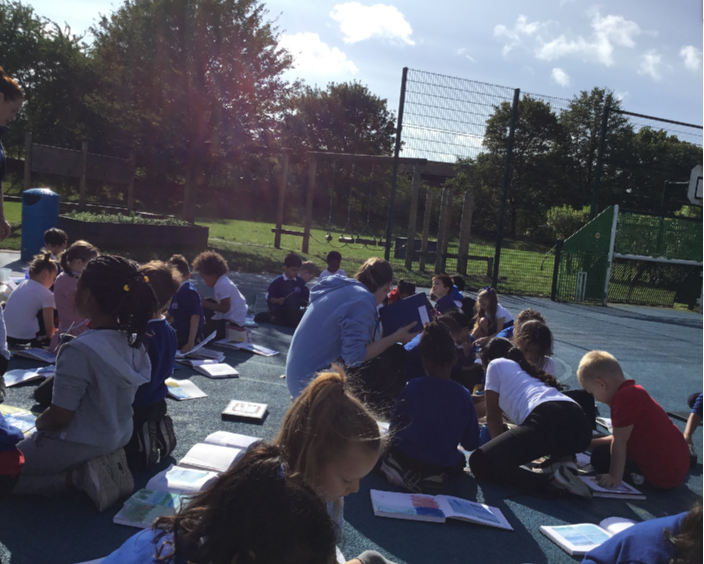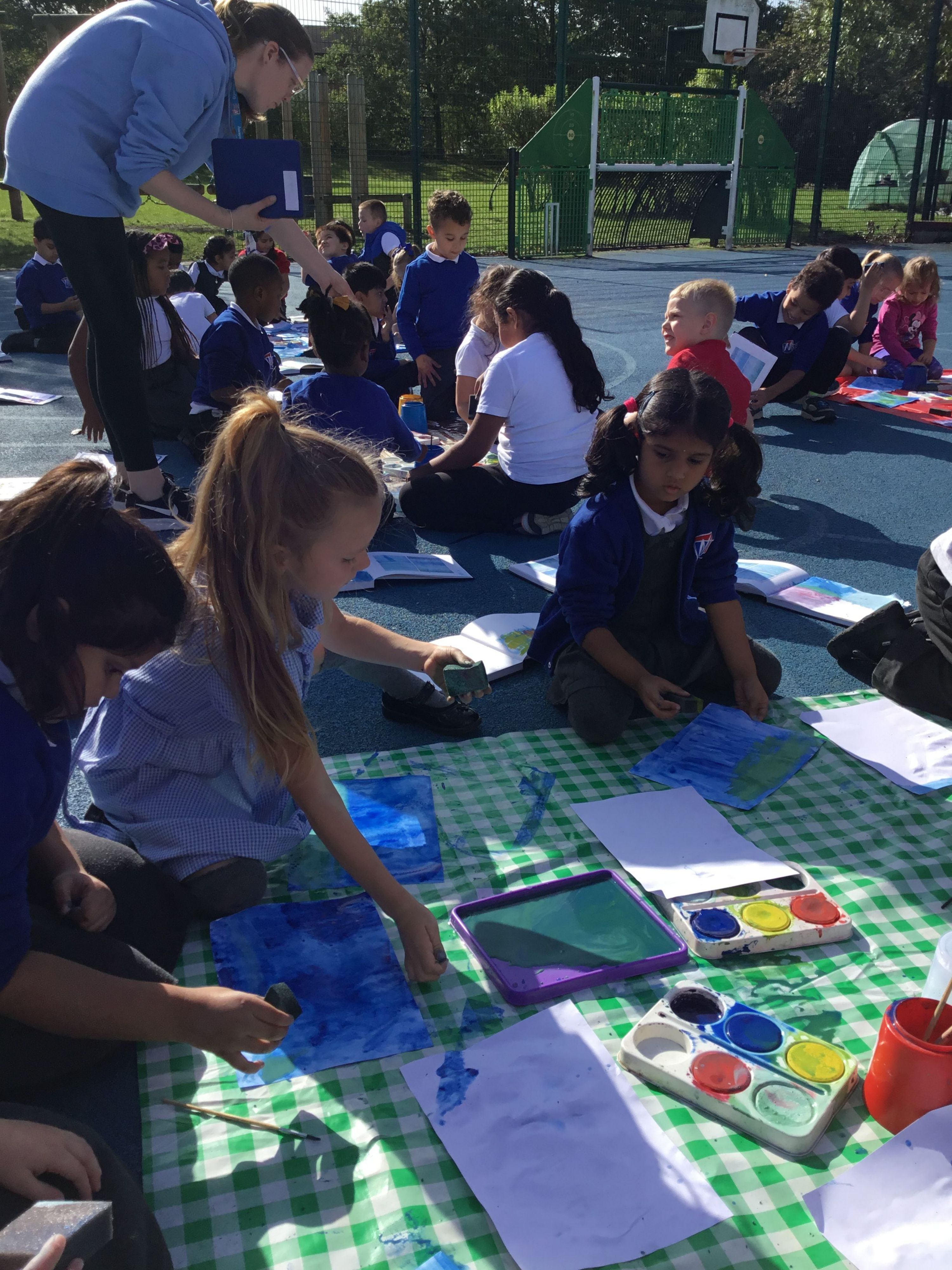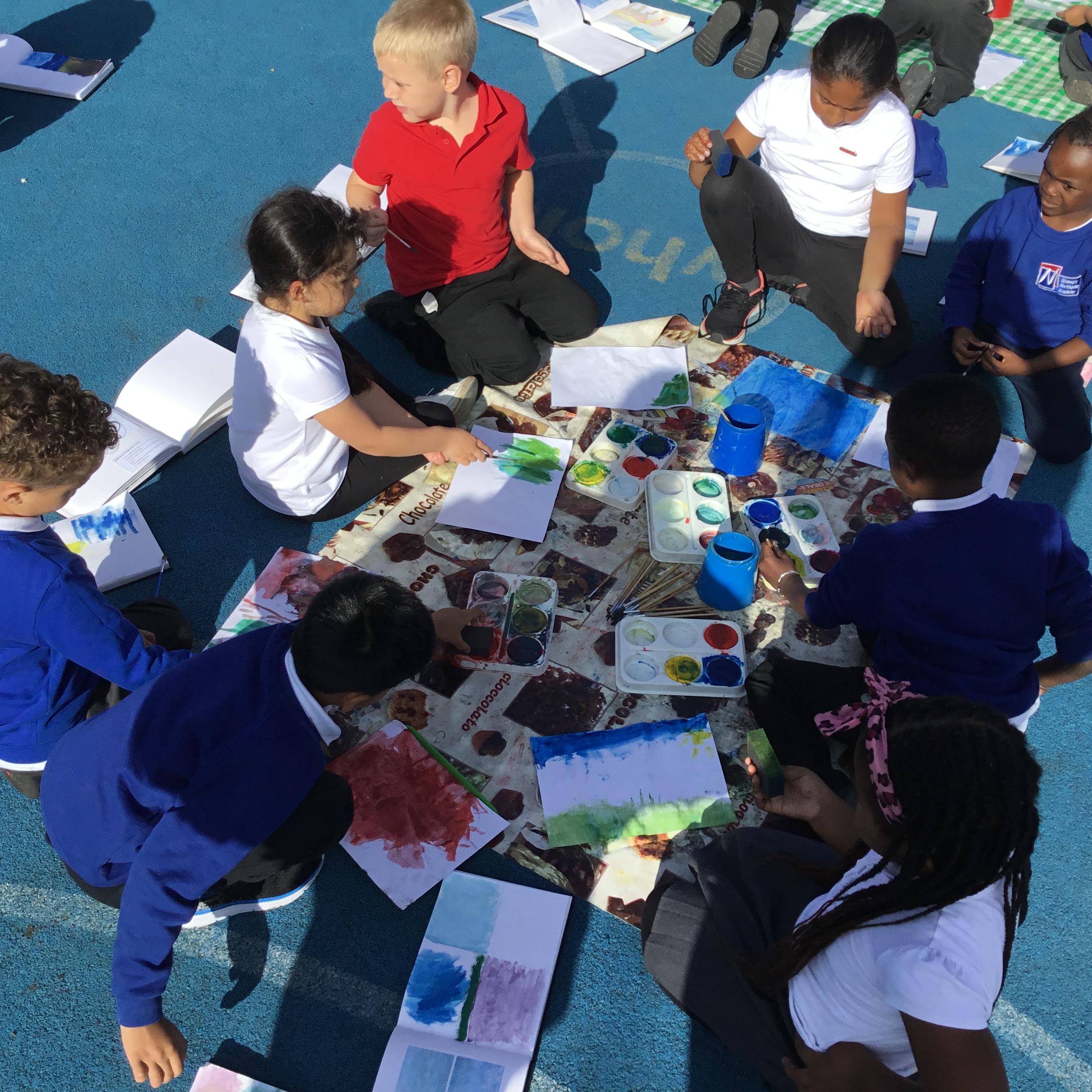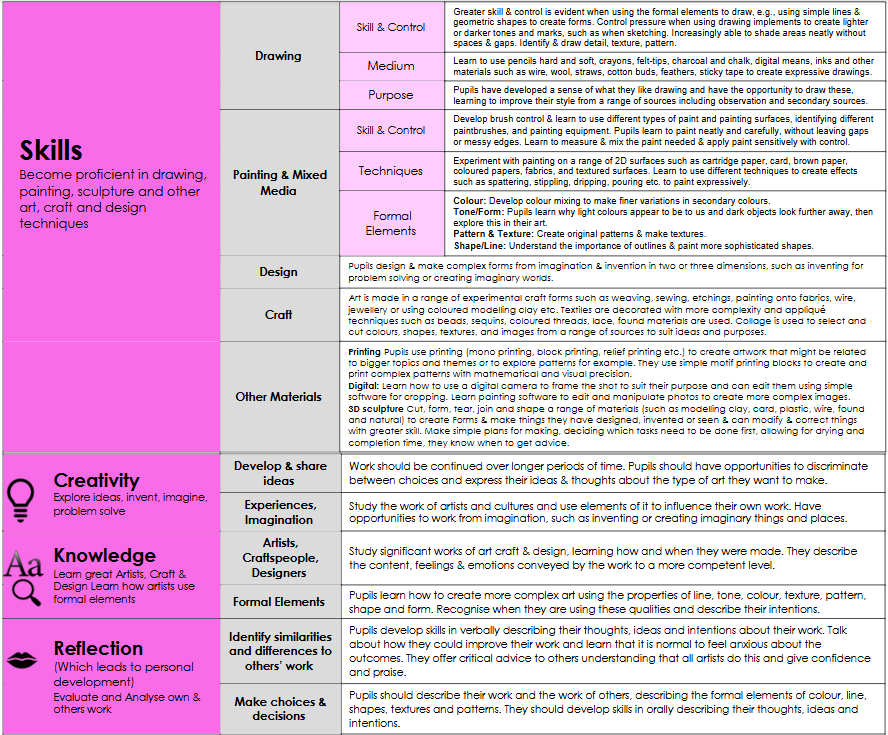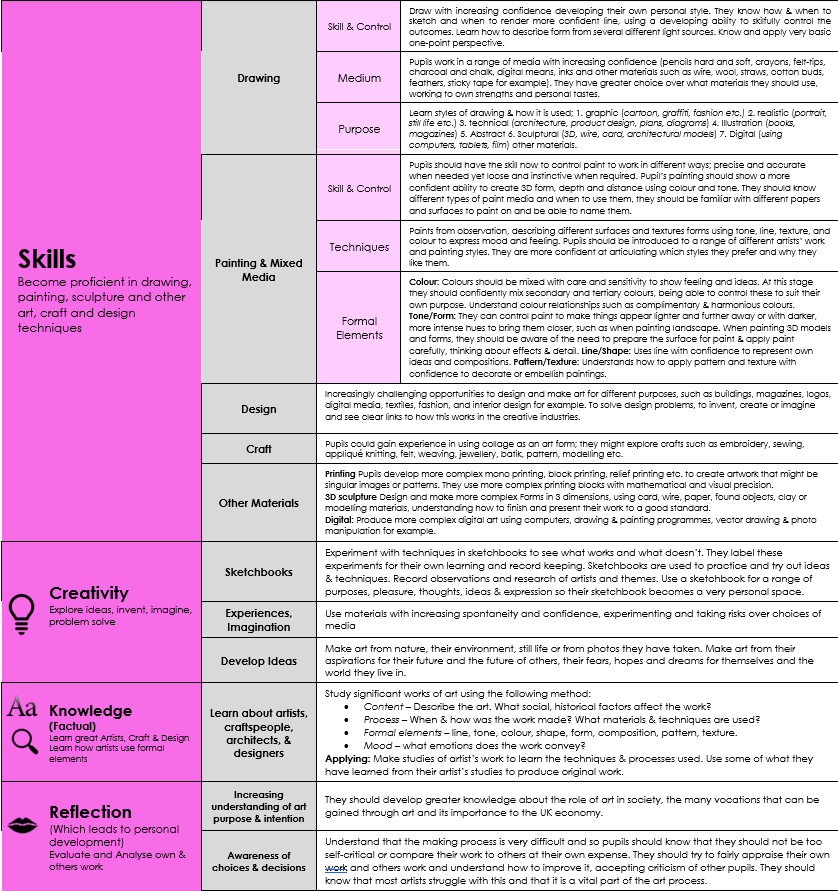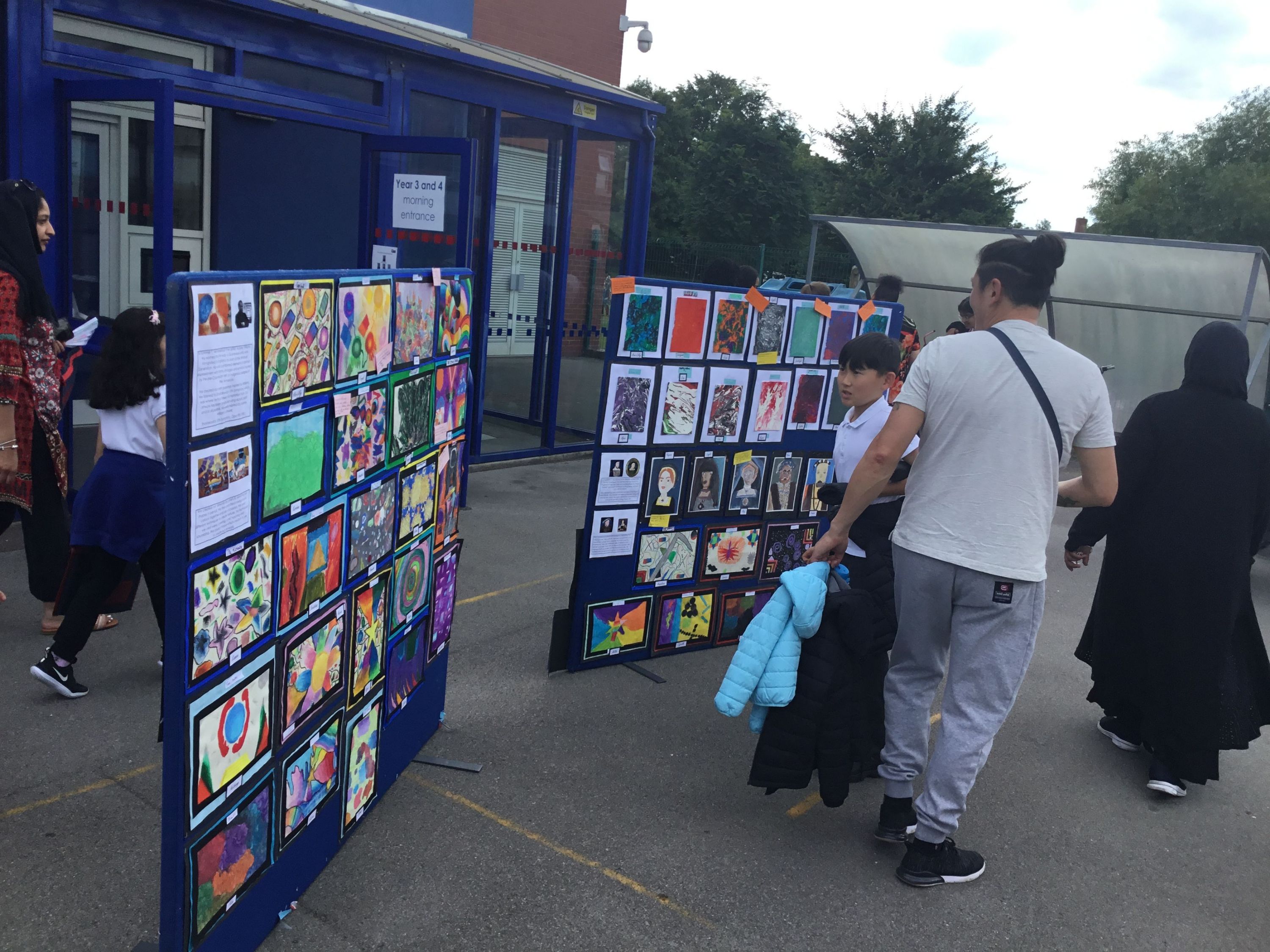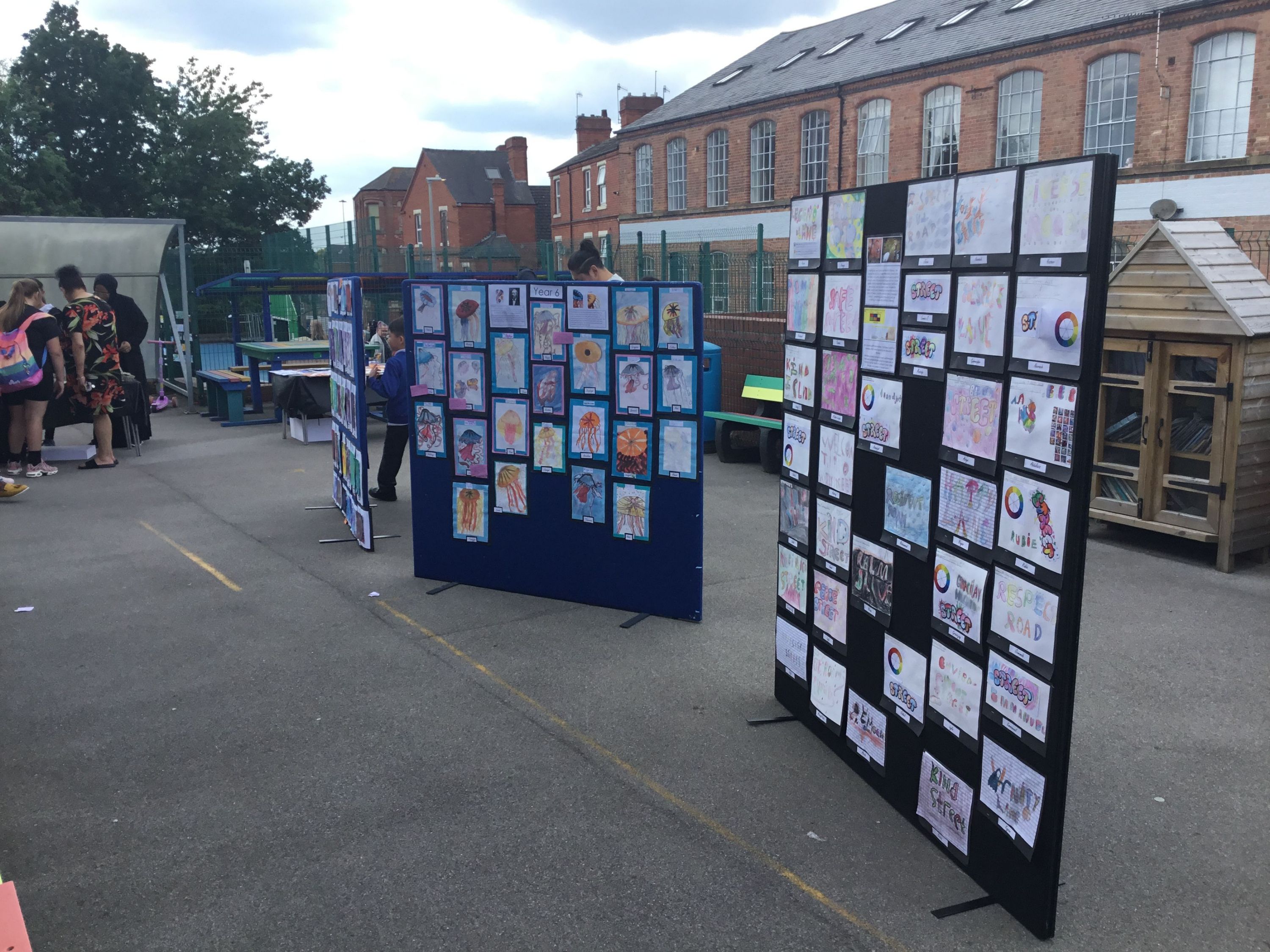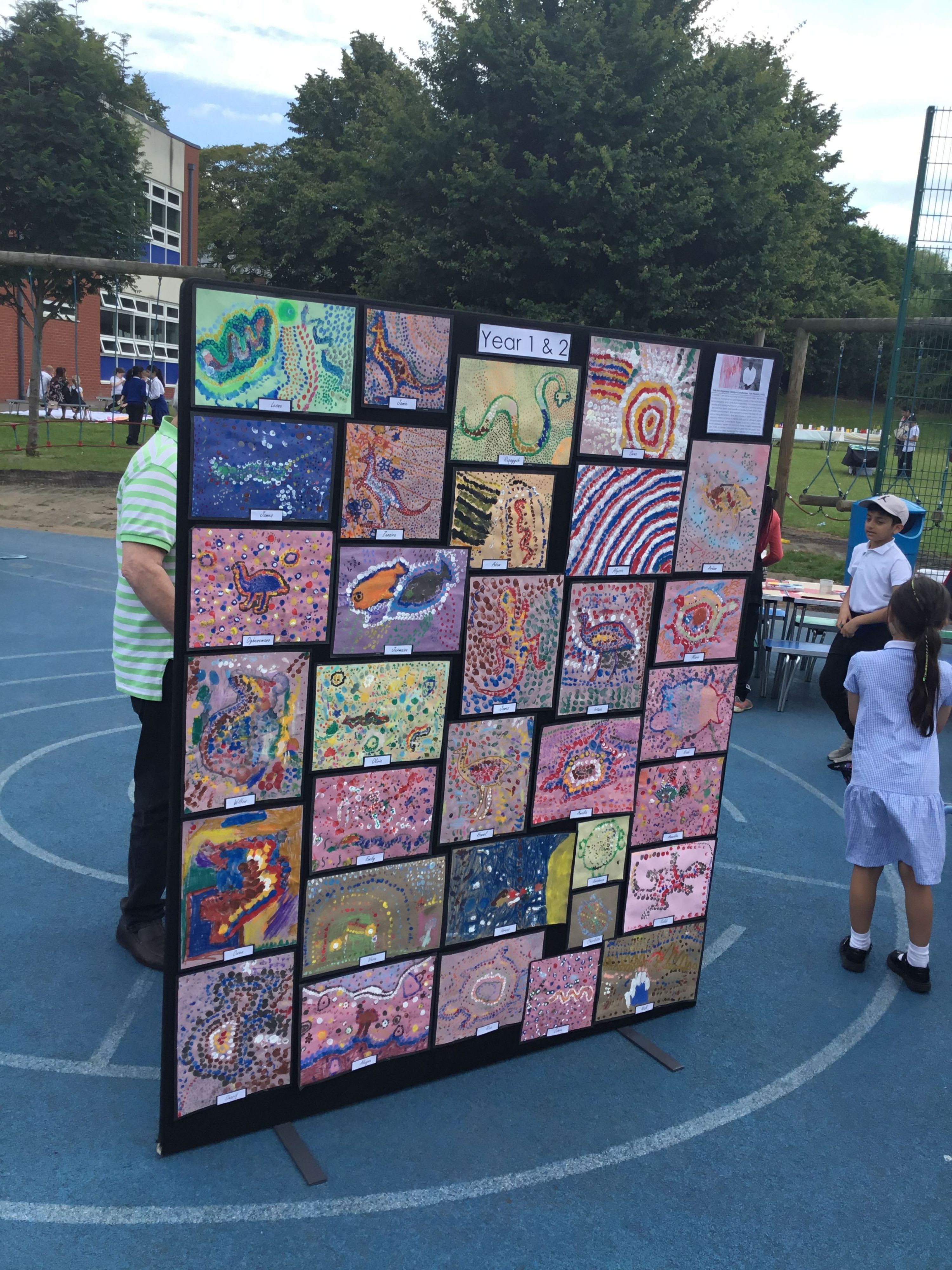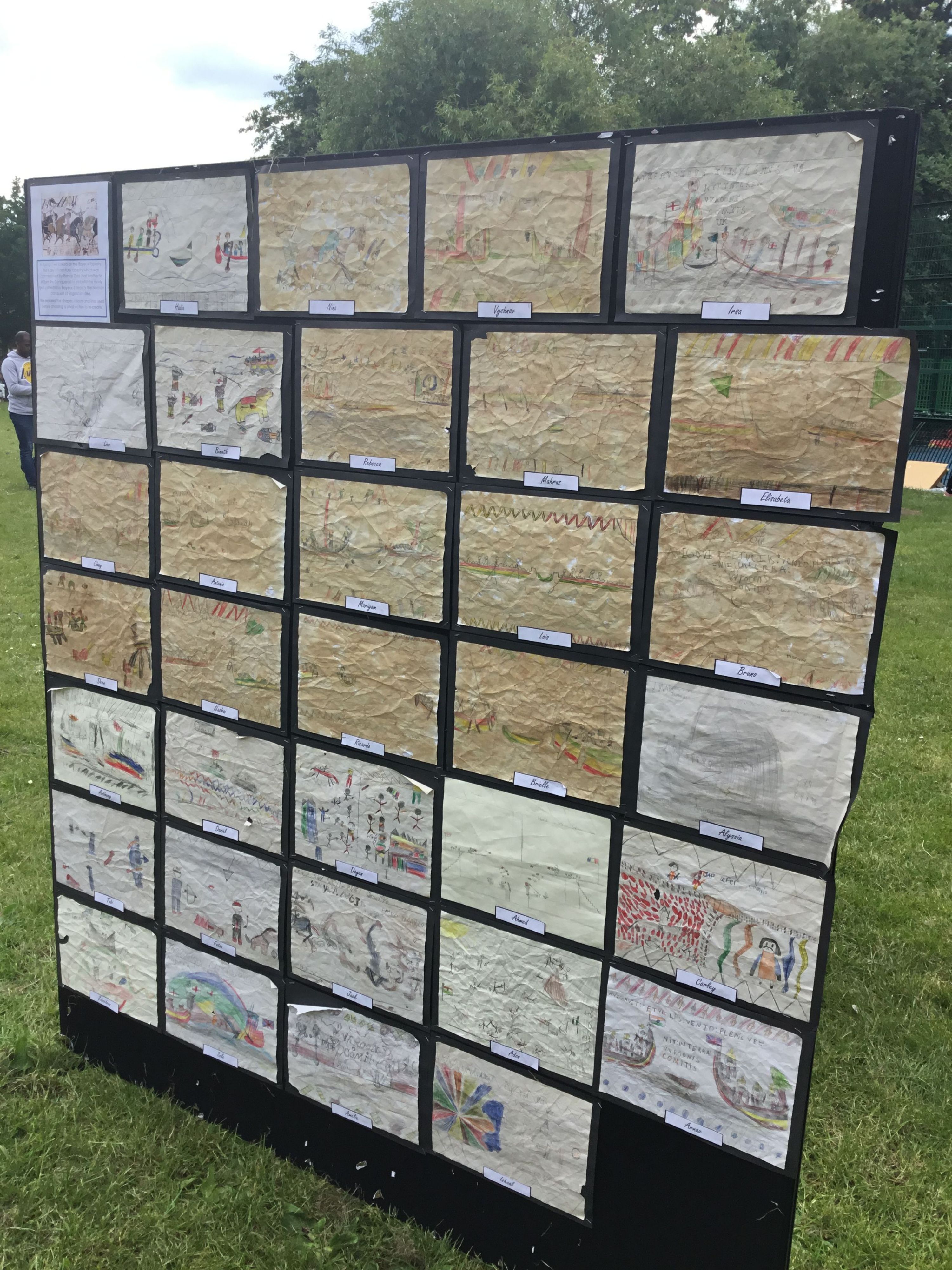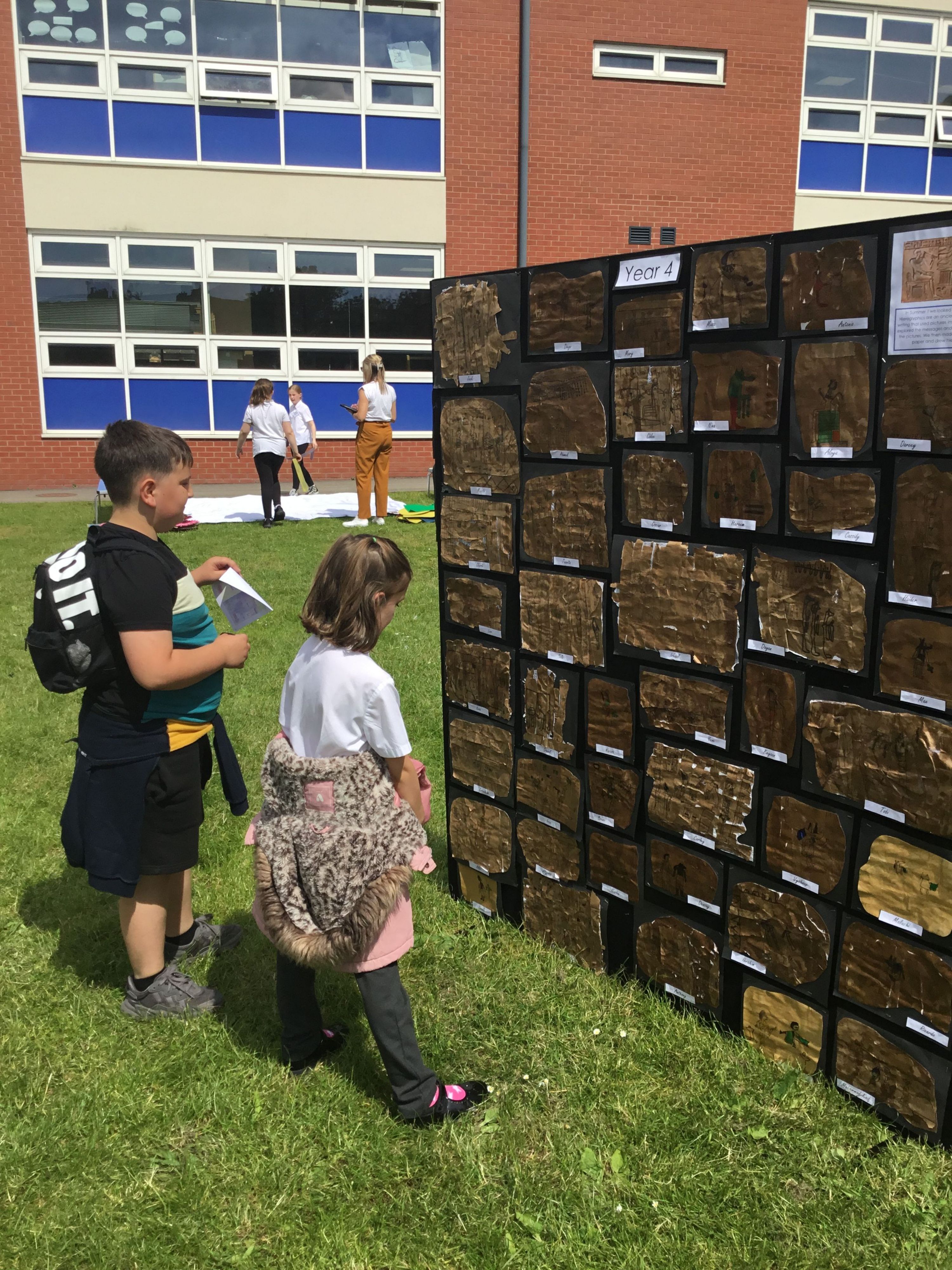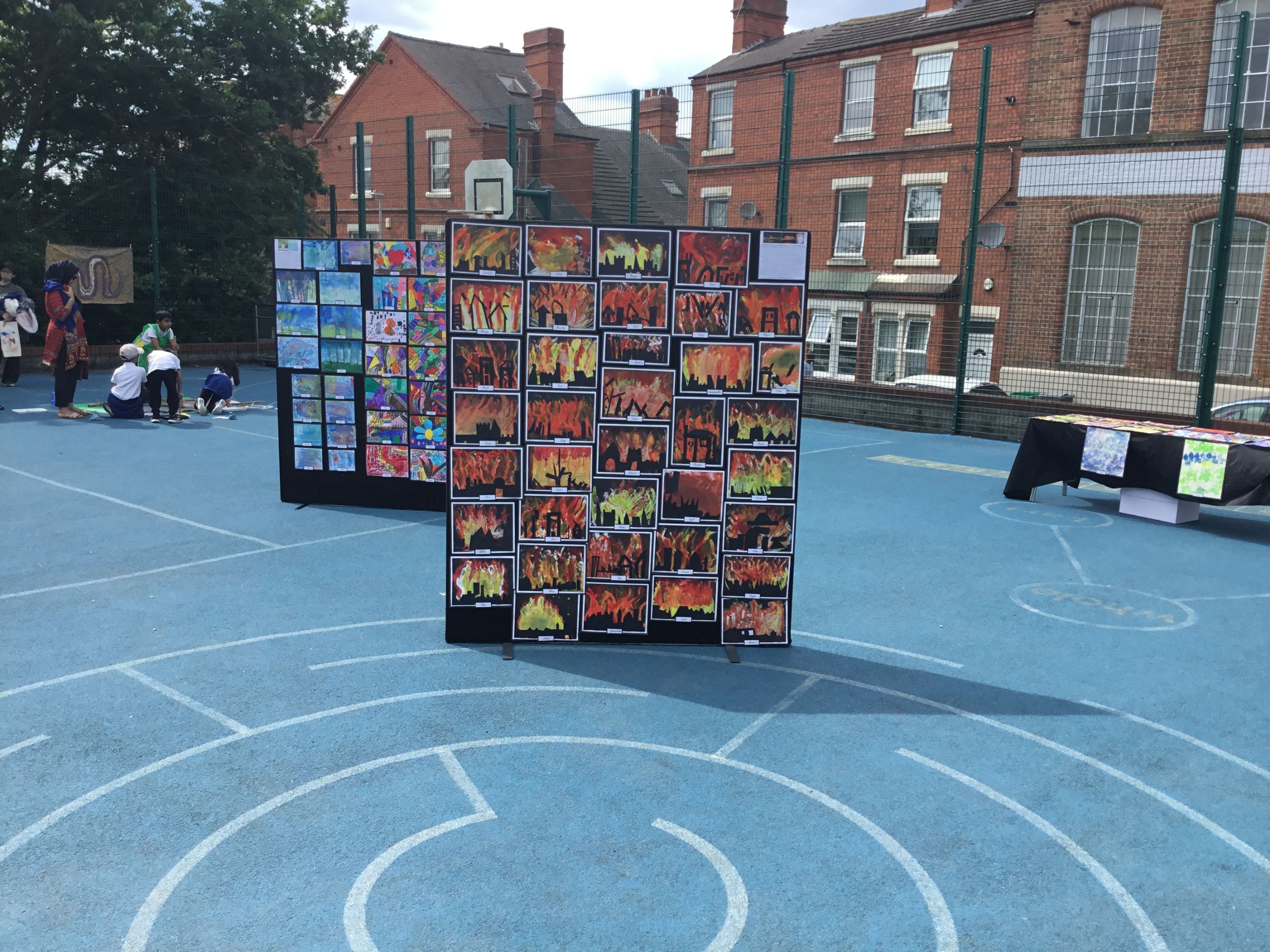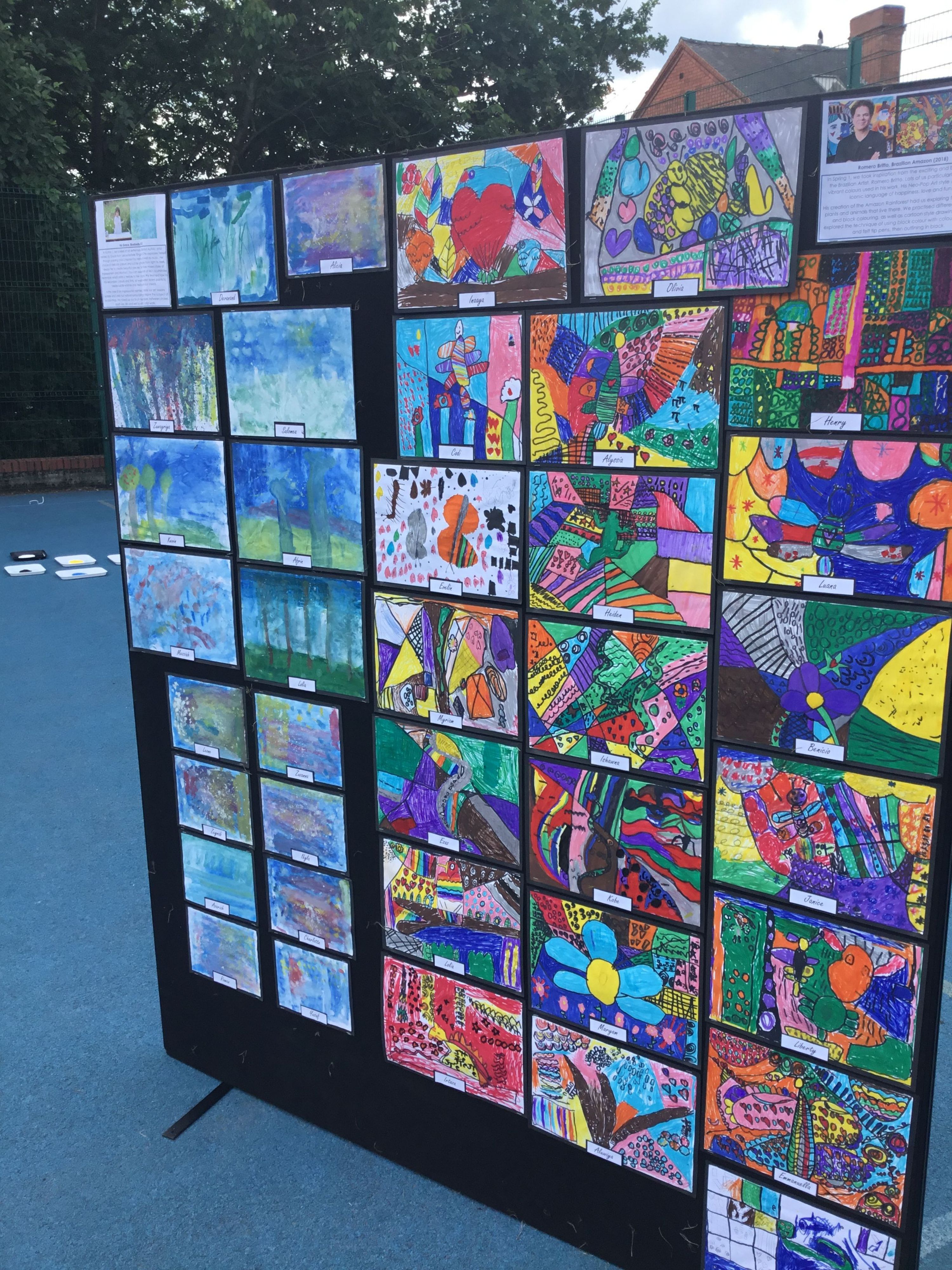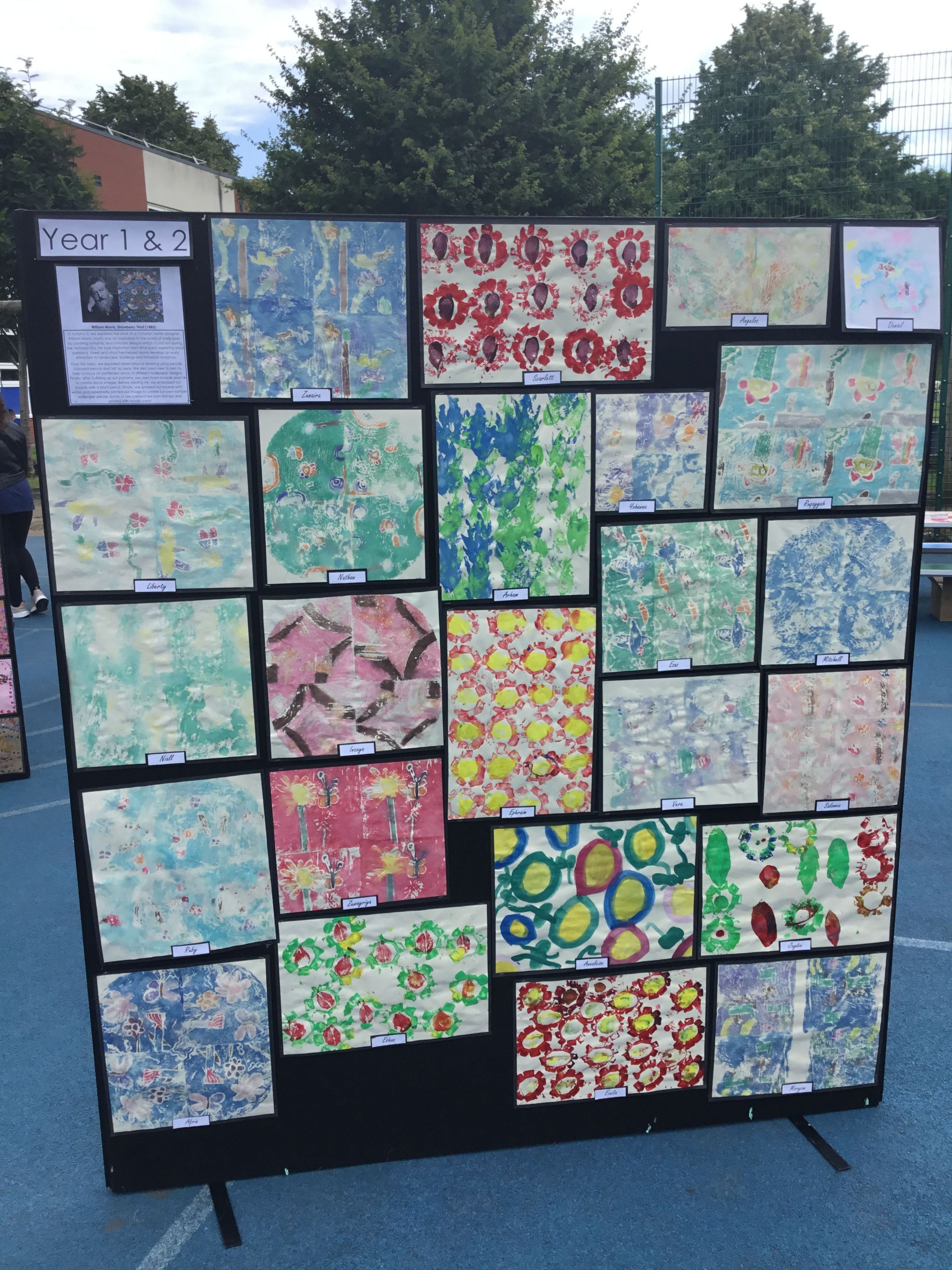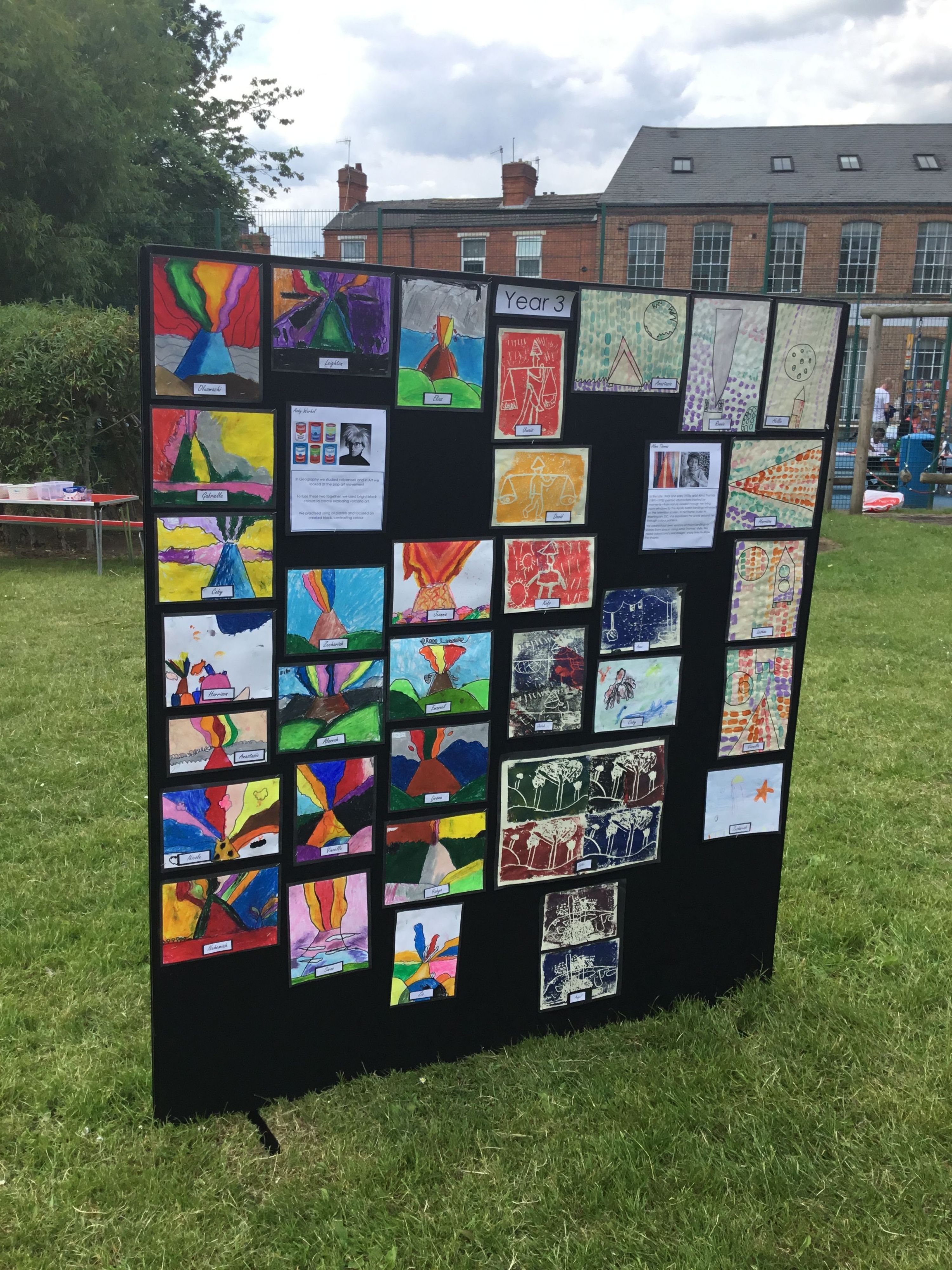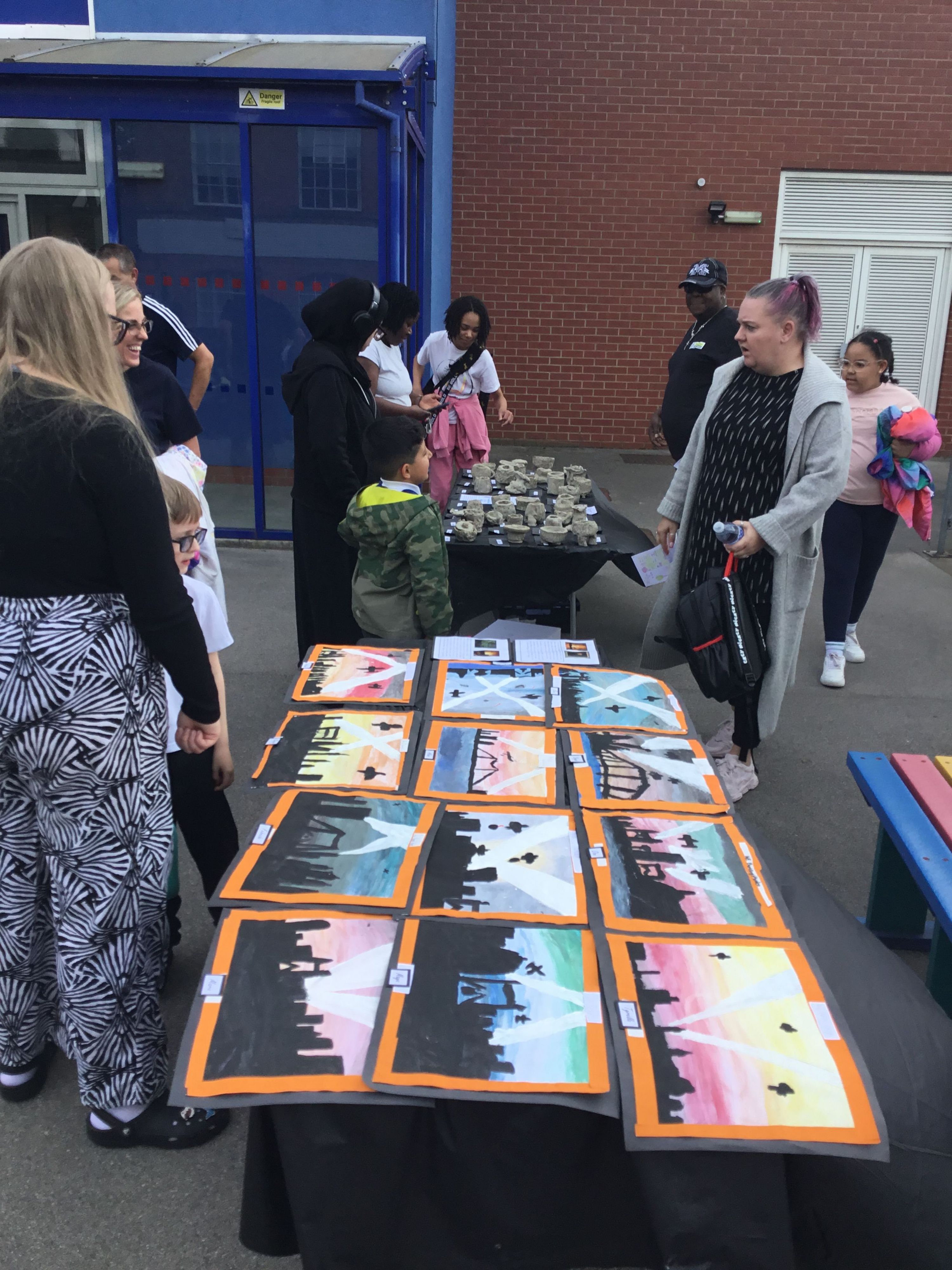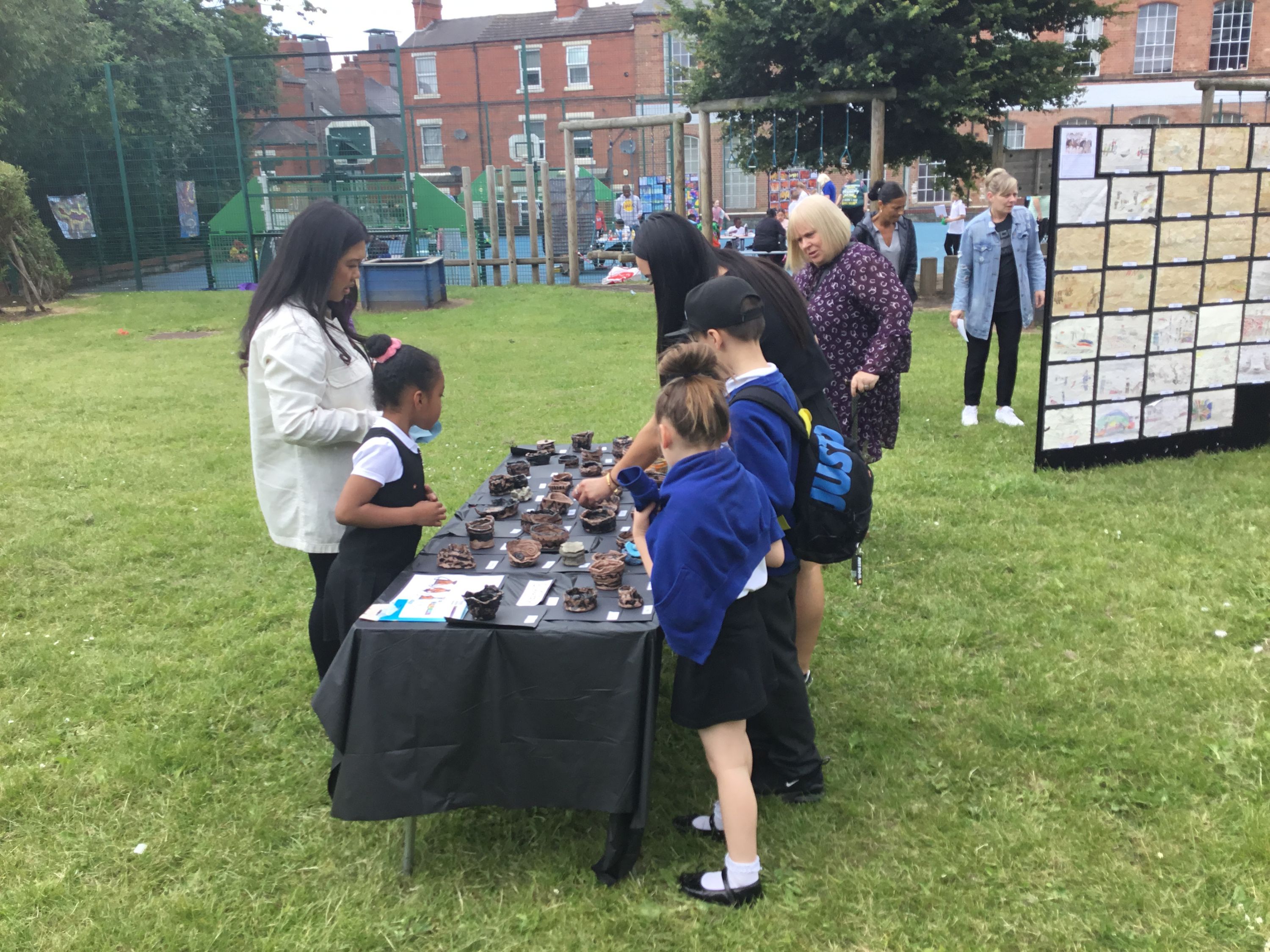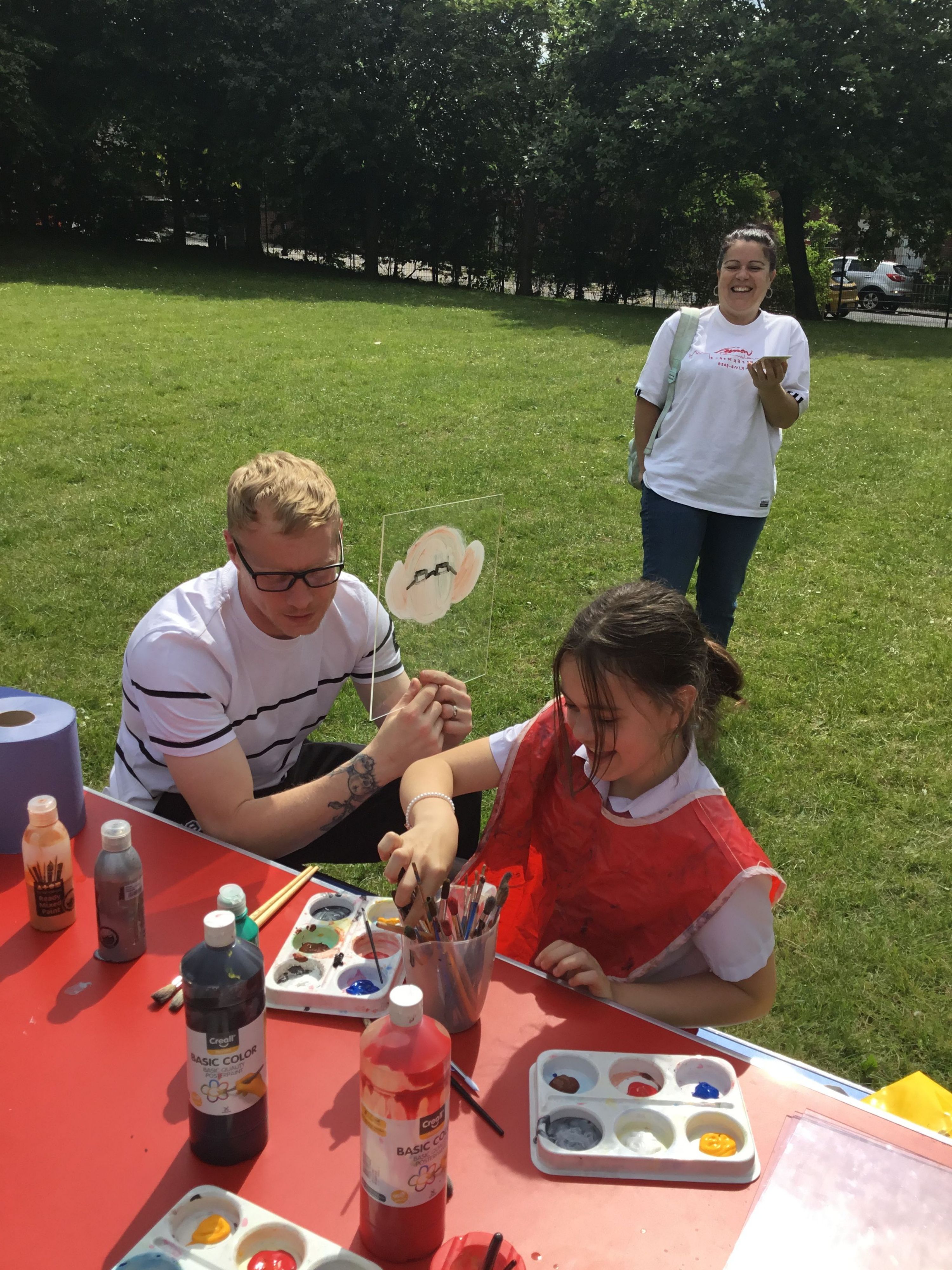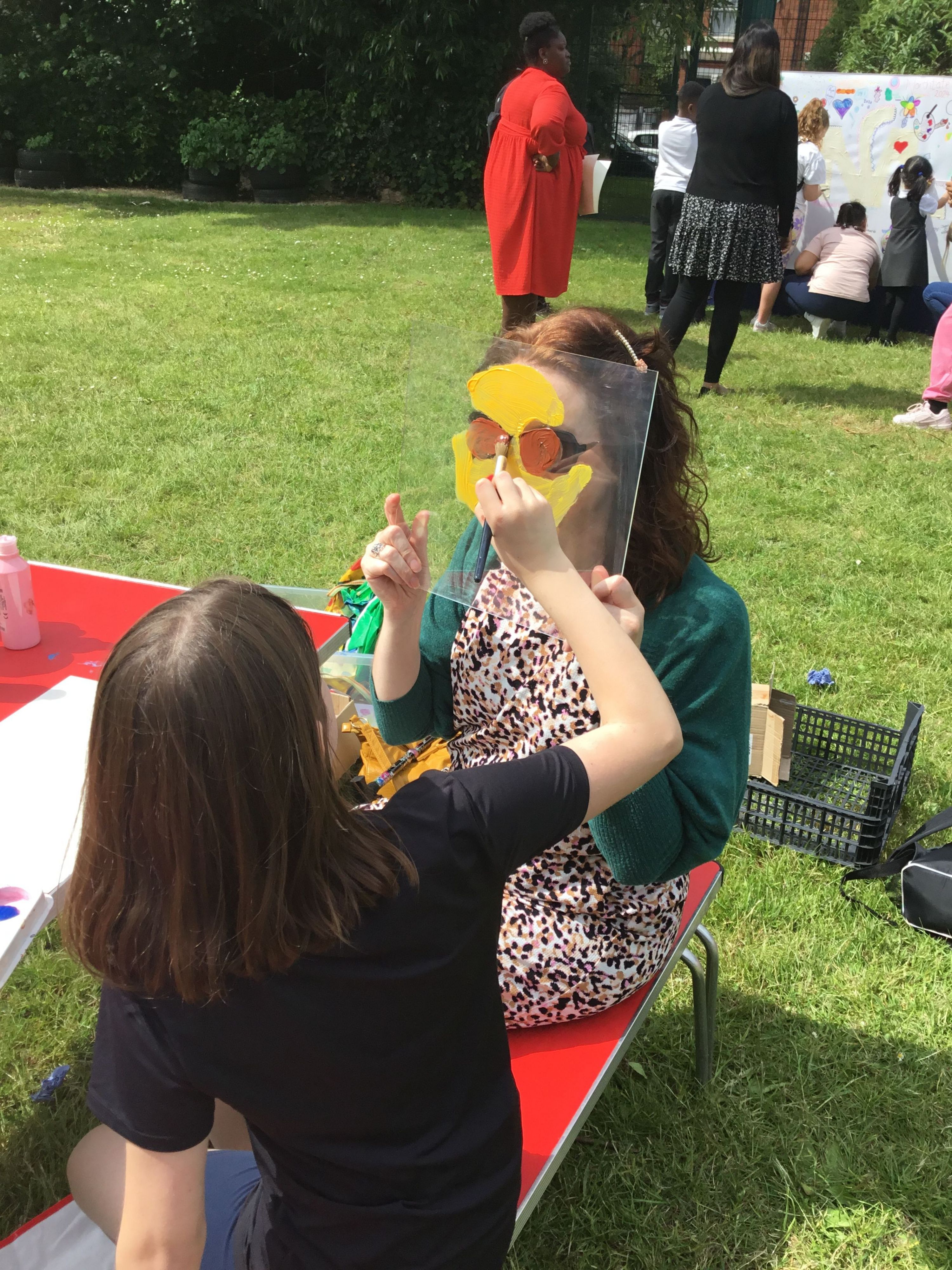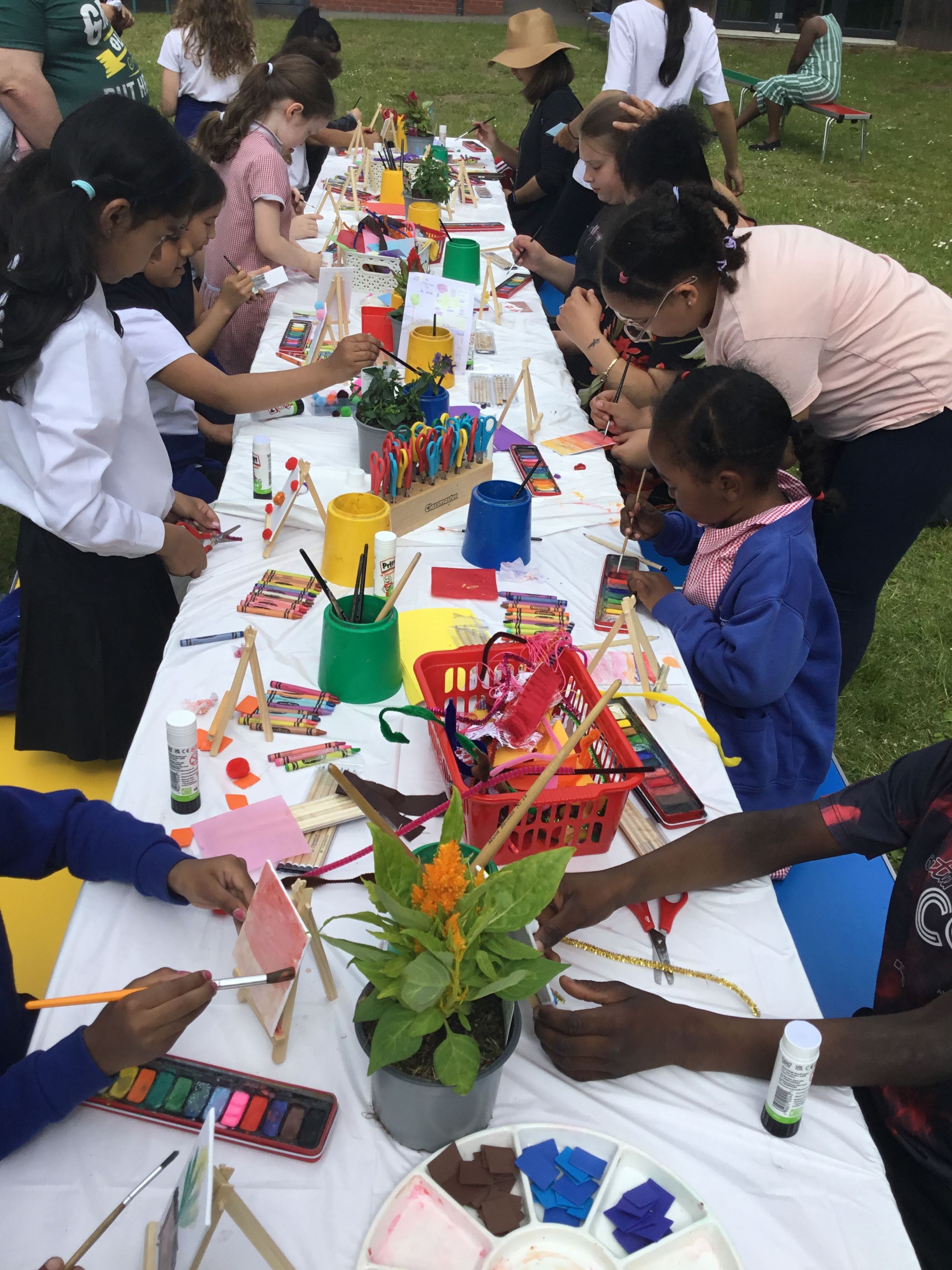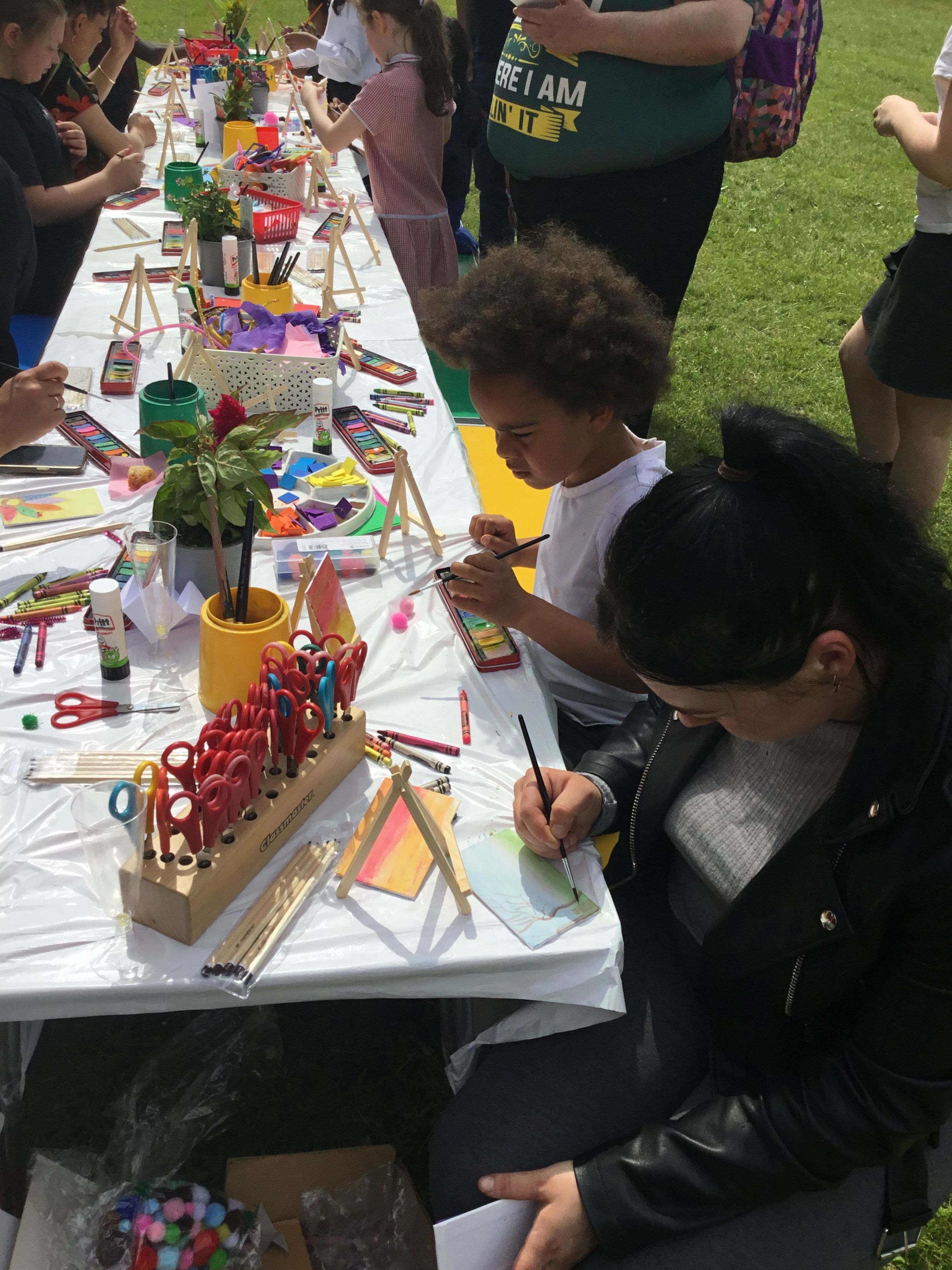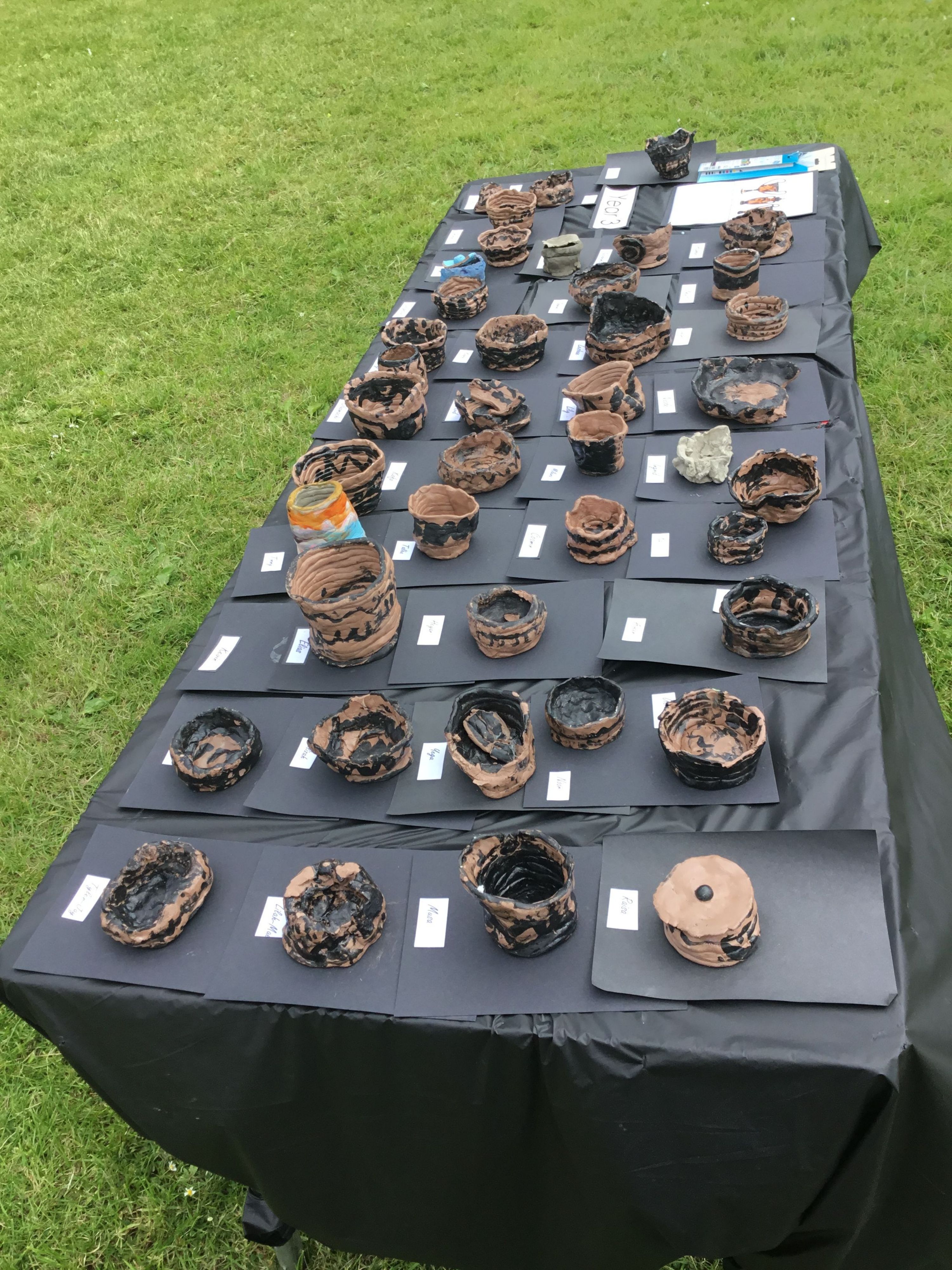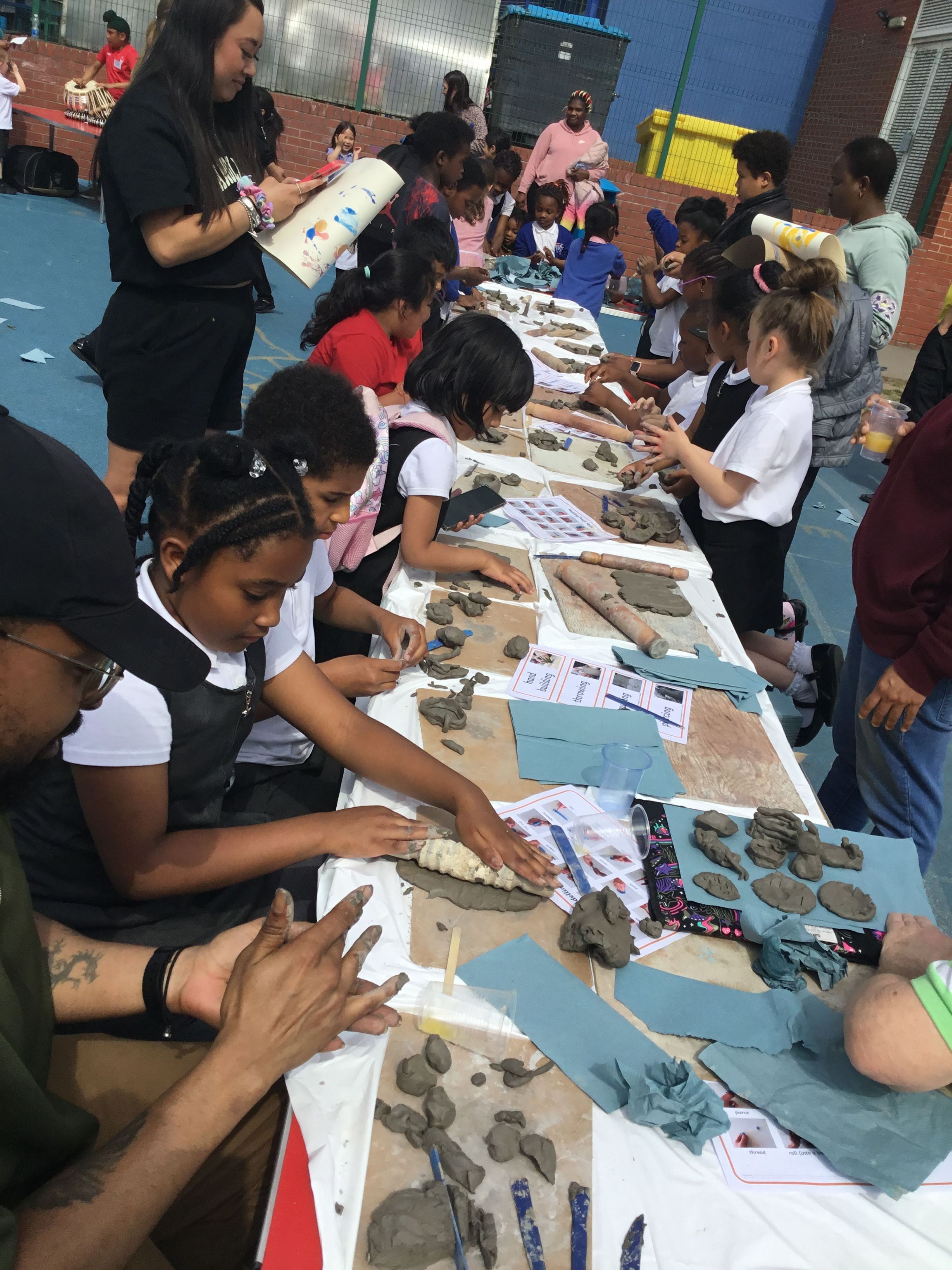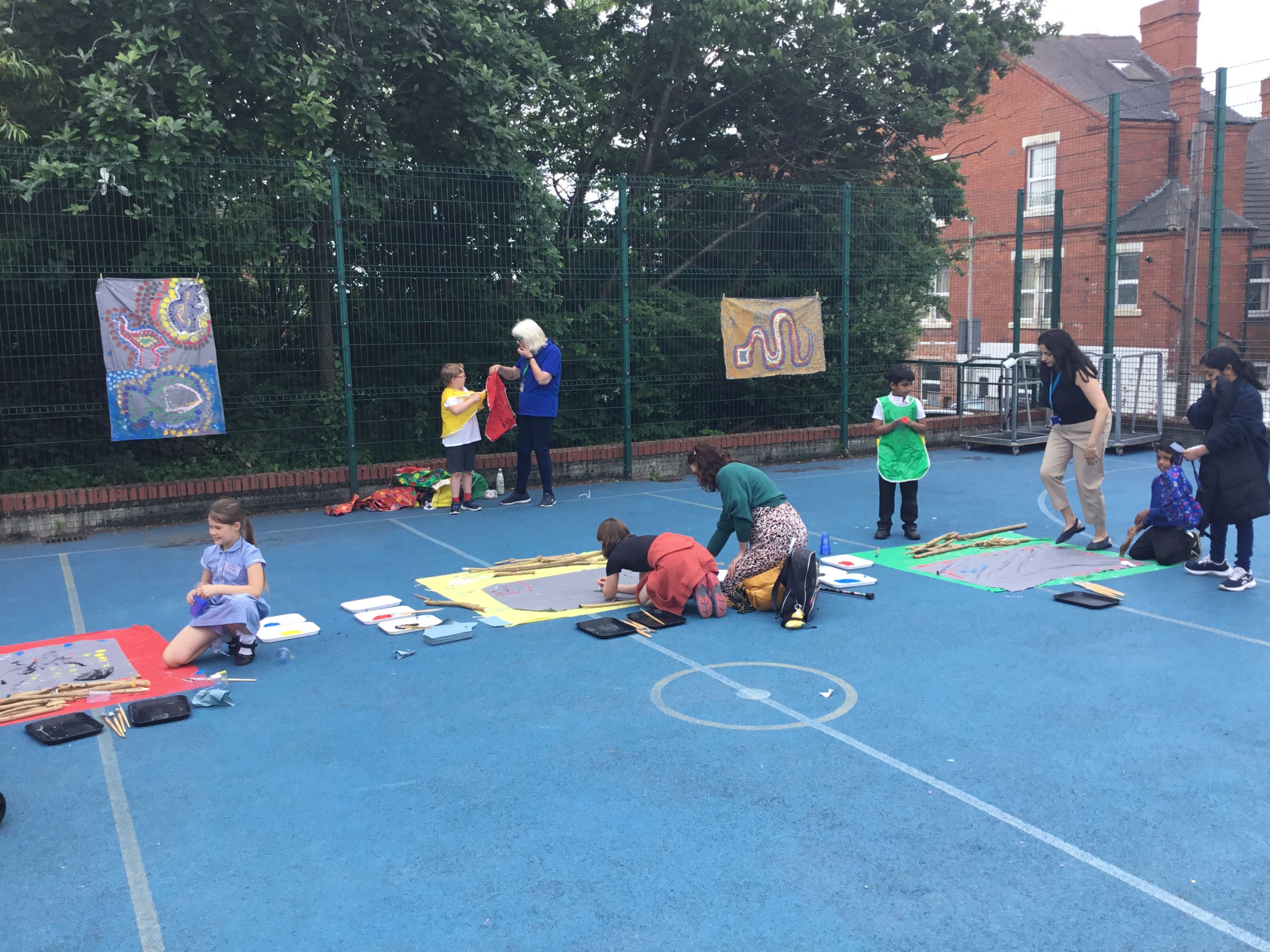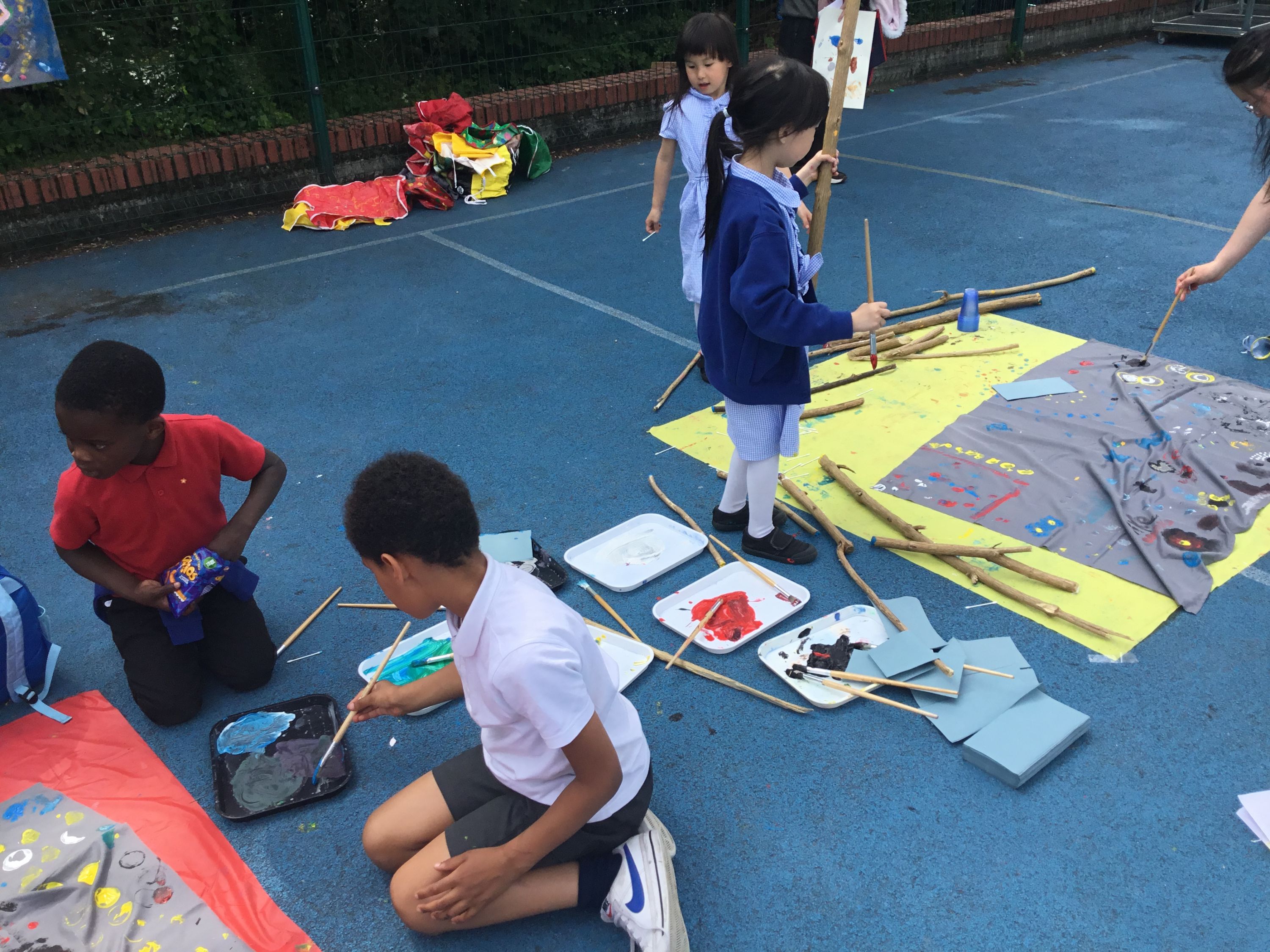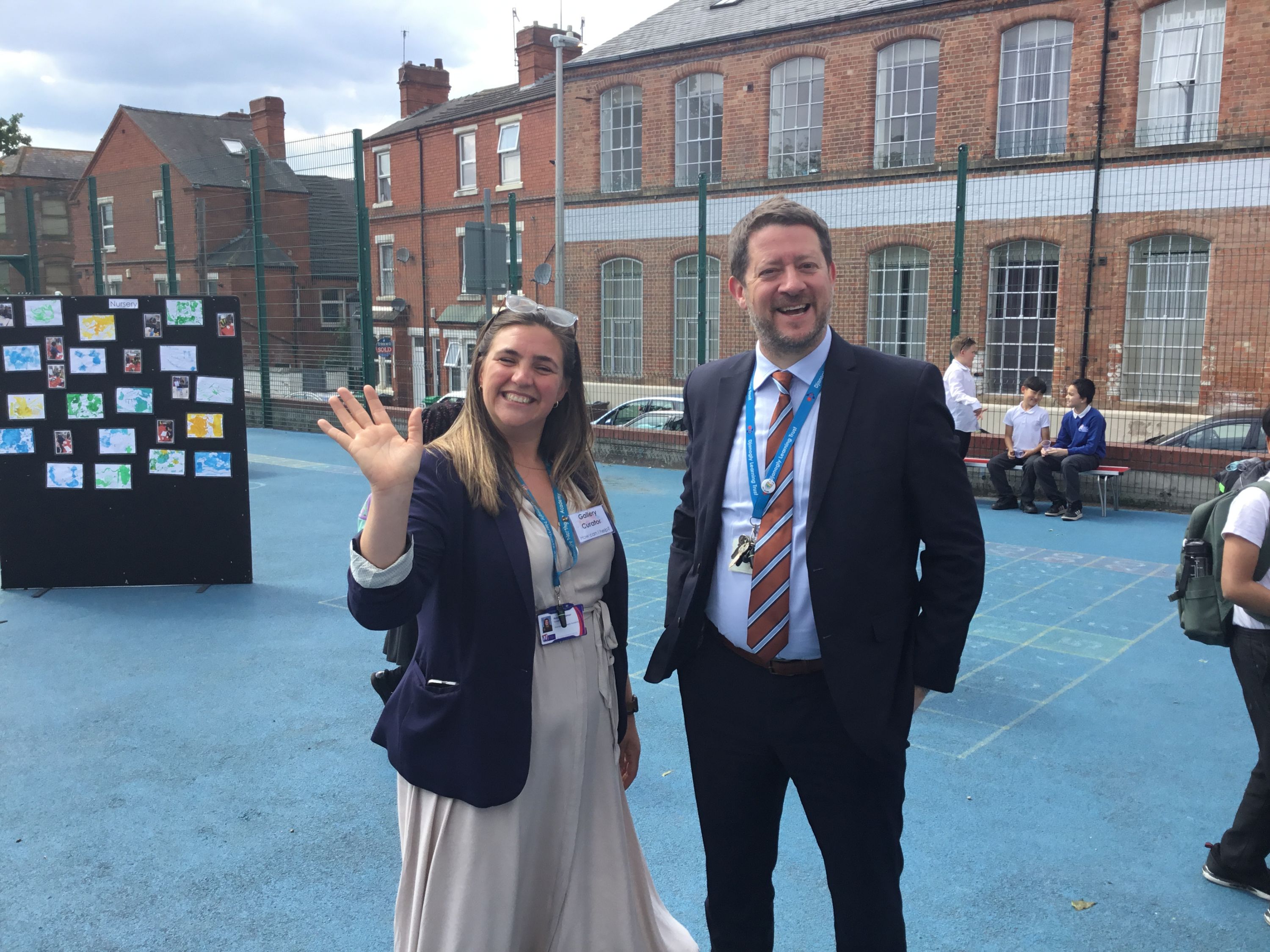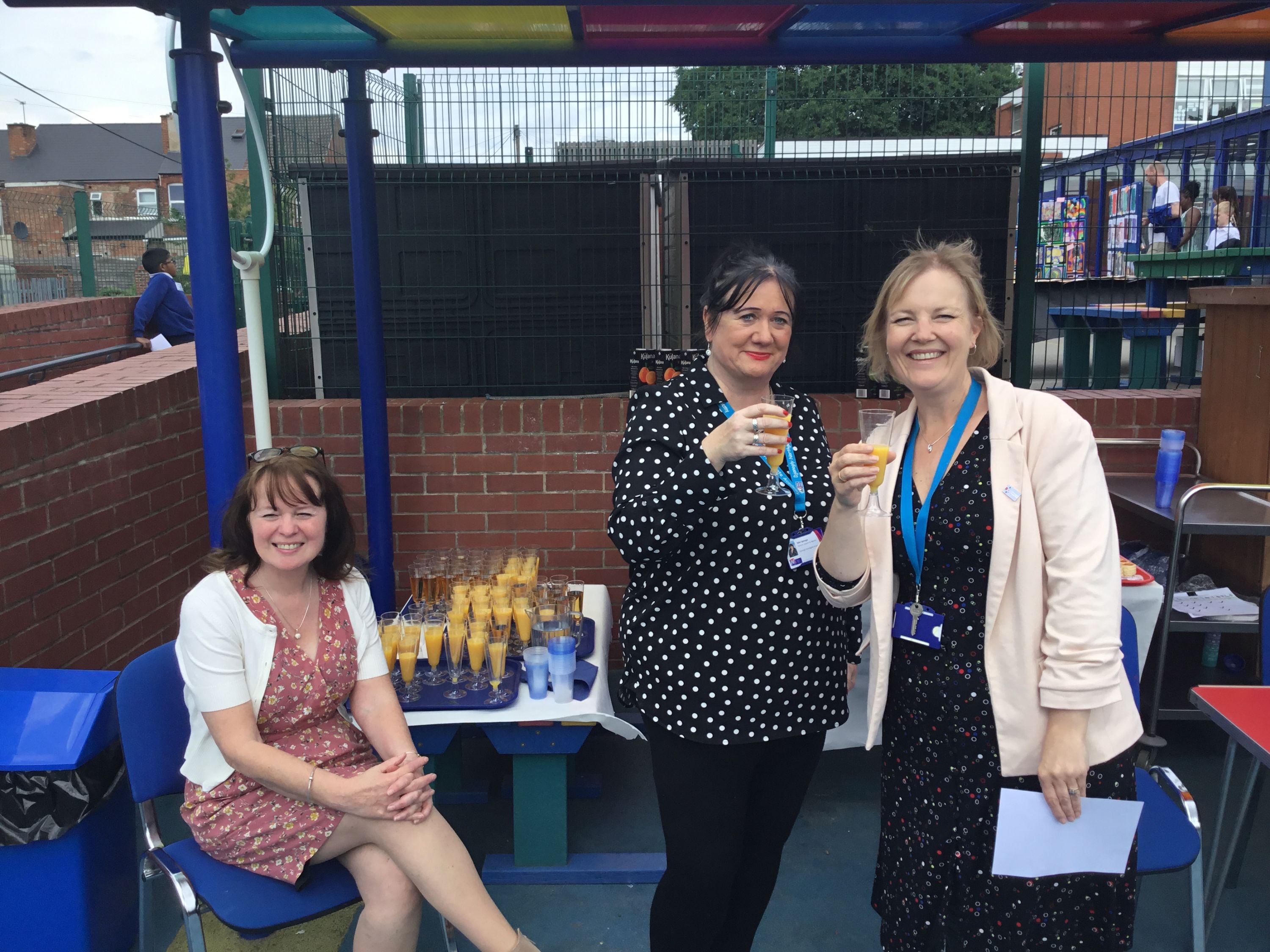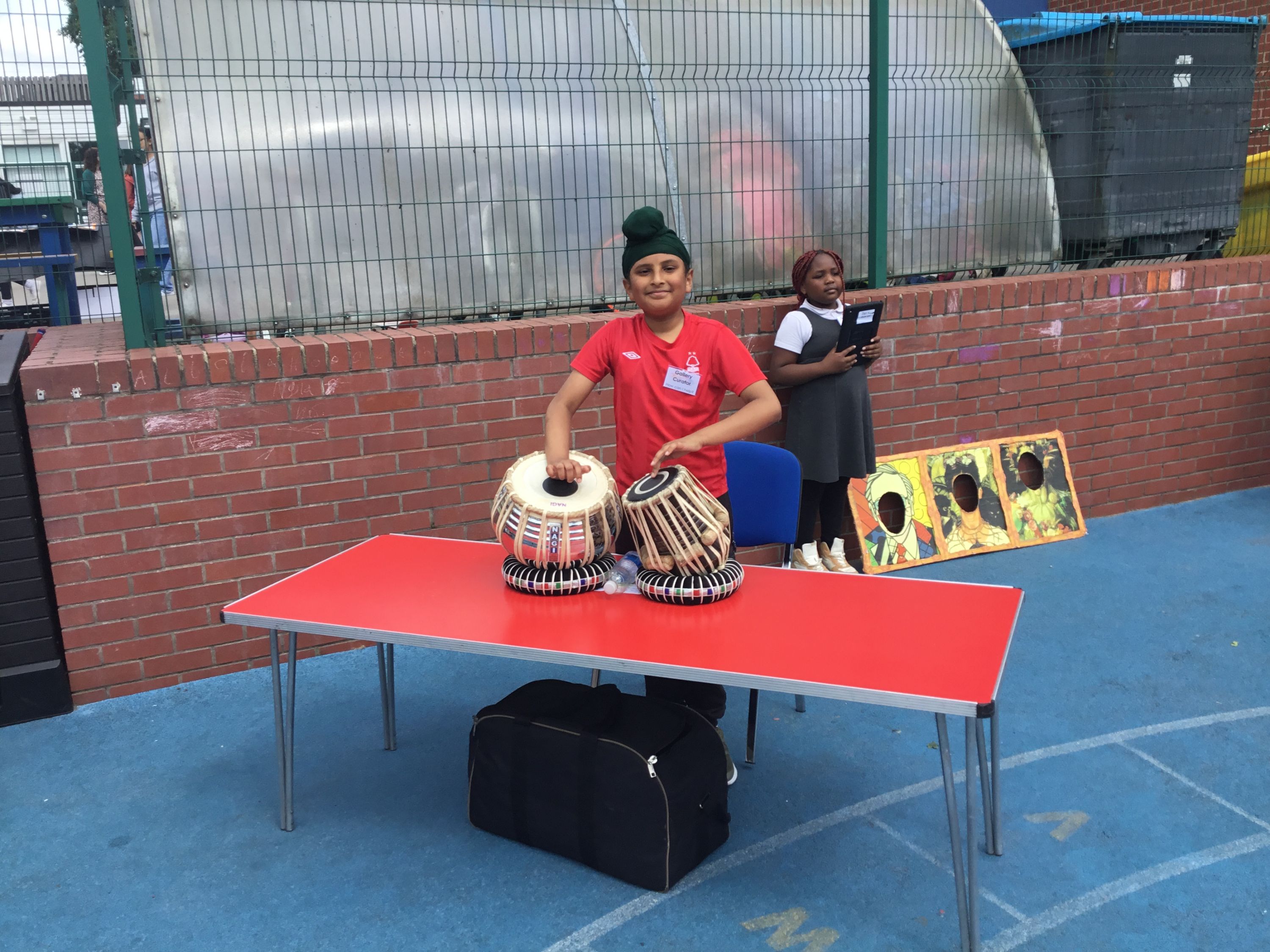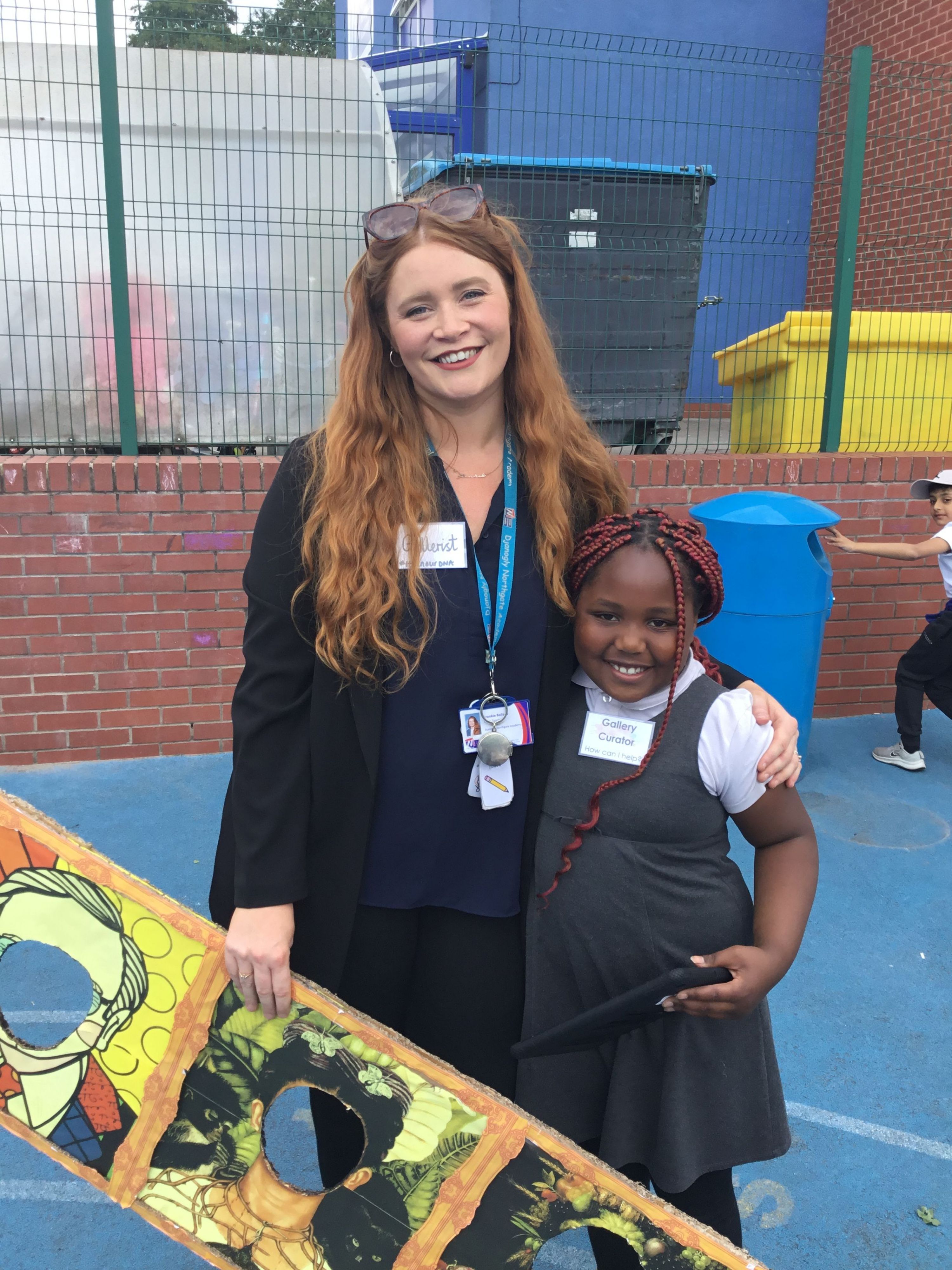Art and Design
'Art' should be interpreted as 'art, craft and design' and artists should be interpreted as artists, crafts people and designers throughout all documentation. Our Art Policy follows whole school guidance on the curriculum and how it is organised, managed, delivered, assessed and evaluated. It also reflects agreed approaches to the whole school issues, i.e. teaching and learning strategies, differentiation, behaviour and discipline, special educational needs and equal opportunities.
Intent
At Djanogly Northgate Academy, we believe art gives children the opportunity to explore the world around them, collaborate with others and express themselves. We believe it is a subject with endless possibilities where every individual can flourish and feel inspired as though they can achieve anything.
We aim to expose our children to a rich diet of art, craft and design, artists and experiences that will allow them to develop a respect and an understanding of different cultures, broaden their horizons and give them the cultural capital they need to be successful, educated citizens. We want to engage, inspire and challenge our children, to equip them with the knowledge and skills to experiment, invent and create their own works of art, craft and design.
Children will build on basic skills and be encouraged to take creative risks all the way through from EYFS to Year 6. In Art, we aim to engage children’s imagination, develop empathy and infuse the curriculum with our Values and Behaviours so that children leave Northgate as emotionally intelligent, confident artists who can share their viewpoints and believe in themselves.
Linking to our Values and Behaviours:
- Discover – Throughout art, children explore a range of traditional, modern and contemporary perspectives, broadening their understanding of the world and how art and design both reflect and shape our history, creativity and wealth. Art and Design also offers opportunities to explore textiles, designs and artists from cultures different to their own.
- Nurture – We create a supportive environment where every child is encouraged to develop confidence in their art abilities, individual artistic flare and interests, as well as utilise art for mindfulness and escapism. Children build on their ability to communicate effectively and reflect on their own designs as well as those of their peers, subsequently using these ideas to improve their work. They will build up collaboration skills, in order to disagree with others’ opinions respectfully, explain why and accept differences in opinion. We provide children with the skills and knowledge they need to develop an appreciation of the world around them and build up their cultural capital.
- Aspire – We inspire children to become skilled, critical thinkers and individualised artists who use their knowledge and love of art to achieve their full potential, set themselves ambitious goals and find creative ways to achieve these. They can experiment and make mistakes, then reflect on how they can improve their work without being told how. Our children can make artistic decisions independently without the input of a teacher.
As they progress through school, they will be able to think critically and develop a more reliable understanding of art and design. This will enable them to know how art and design both shape and reflect our history, contributing to the culture, creativity and wealth of our nation.
We analyse and interpret artists and their artwork
Our children take into account artistic preferences and techniques. Pupils will be reviewing artists' work throughout history and suggesting how these are successful or how they could have been improved. By studying significant works of art we use the following method:
-
Content – Describe the art. Social, historical factors affect the work.
-
Process – When & how made? What materials & techniques are used?
-
Formal elements – line, tone, colour, shape, form, composition, pattern, texture.
-
Mood – what emotions do the work convey?
This allows our children to conduct studies of an artist’s work, to learn the techniques and processes used and apply some of what they have learnt to produce original work later on.
We build effective oral and written communication
Our pupils will be discussing and debating different artists work and techniques. They use appropriate vocabulary and sentences when discussing artistic work, both orally and in sketchbooks. Our children develop the skill to use technical vocabulary appropriate to their year group and build on this as they progress through school. Children have the opportunity to develop their own opinions about the art that they encounter and express this in a purposeful and respectful manner. Our teaching will allow pupils to coherently develop their ideas in their sketchbooks, allowing them to successfully discuss their ideas.
We teach our children the skills of adaptability and agility
Throughout our art units, pupils can make changes to their work when something is unsuccessful and use different materials and techniques to help inform their decision for their final piece.
We build curiosity and imagination
Our children will investigate different colours, textures, forms and patterns. They will develop a deep understanding through questioning and wondering, as well as explore the effectiveness of materials, mediums, artists, techniques and movements. Throughout the pathways of learning, our children will have the opportunity to develop their ideas and try out the ideas they have.
We promote initiative and individuality
At Northgate, children develop original ideas by using the knowledge they have of the world around them, cultures and historical influences. We believe it is important to develop each child as an individual and celebrate their interpretation of work they have been influenced by.
Implementation in Art
Art is a progression through which all our children will be given opportunities to develop specific skills, knowledge and understanding, enabling them to work with a variety of media and experiment with different styles and forms. At Northgate, we plan and deliver learning sequences from a variety of art strands; painting, printing, drawing, mixed media, craft and sculpture. Within these strands there are opportunities for children to explore a variety of materials, artists, designers, architects and craftspeople. Our teaching of art will enable all children, of all abilities, to use their creative imagination to achieve their potential. Alongside this, we train and develop high expectations and quality sketchbook use, where children can log and experiment with technical skills, processes, thoughts, ideas and designs.
Where does art begin?
Early Years
In the Early Years, Art is taught as an integral part of the thematic work covered throughout the year. Our children cover a variety of artists and styles of work across the year, which lay out the foundation blocks for their progression of artistic skills, leading them through to Year 6. We follow the Early Years Framework objectives for developing a child’s understanding of ‘creating with materials’ and 'being imaginative'. Every day, our pupils are provided with the opportunity to access creative resources independently in continuous provision, enabling them to apply the skills and techniques they have practised during adult-led activities. Children have opportunities to use tools and techniques to shape, assemble, join and construct with a purpose in mind, whilst experimenting with colour, design, texture, form and function. Through a language-rich environment, children are exposed to artistic vocabulary. Artistic language and discussions are valued by our EYFS practitioners and adults enable children to extend their creative thinking through purposeful interactions.
We teach our children to develop their control and confidence when drawing using a range of materials, including forms using the formal elements of lines & simple shapes such as circles, squares and triangles, and draw in different ways to create different effects. This gives our children the confidence to create things they like and learn to draw for pleasure and relaxation, from imagination and observation and recording ideas, thoughts, feelings and drawing for narrative reasons. All of these support the key development of our children's fine motor skills.
Long-Term Plan of Diverse Artists Extensive Art Experiences
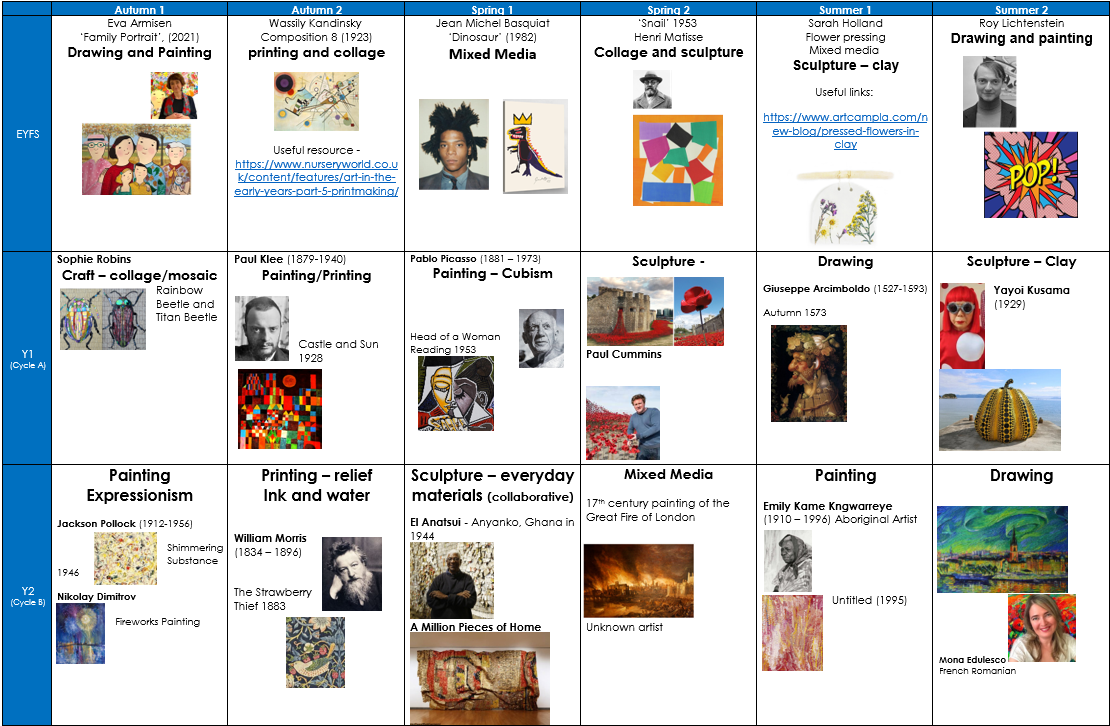
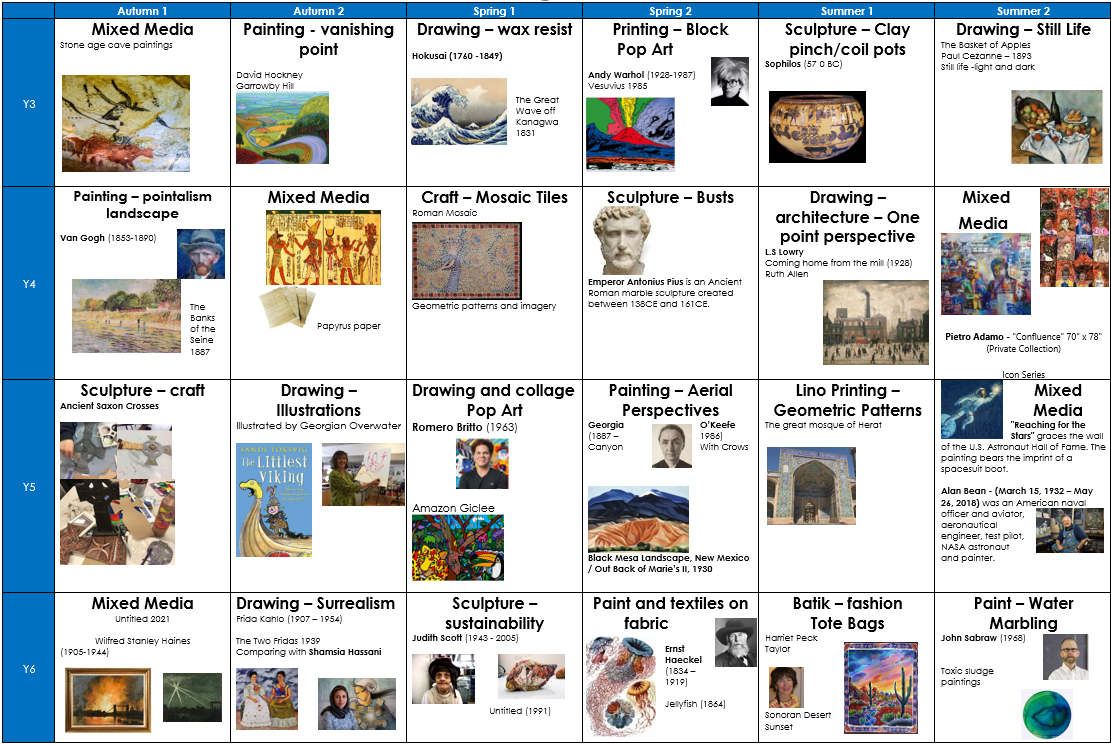
Taking the Classroom Outside
Observational drawing
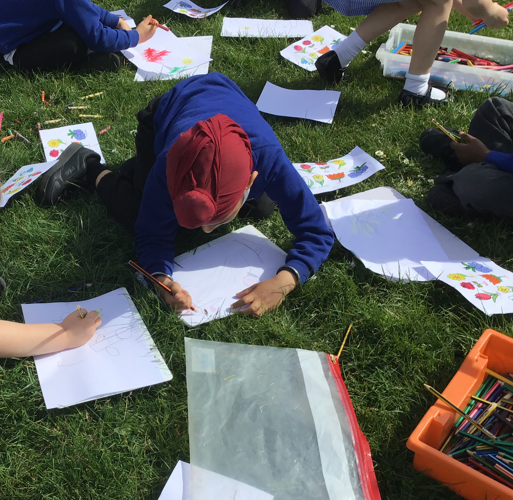
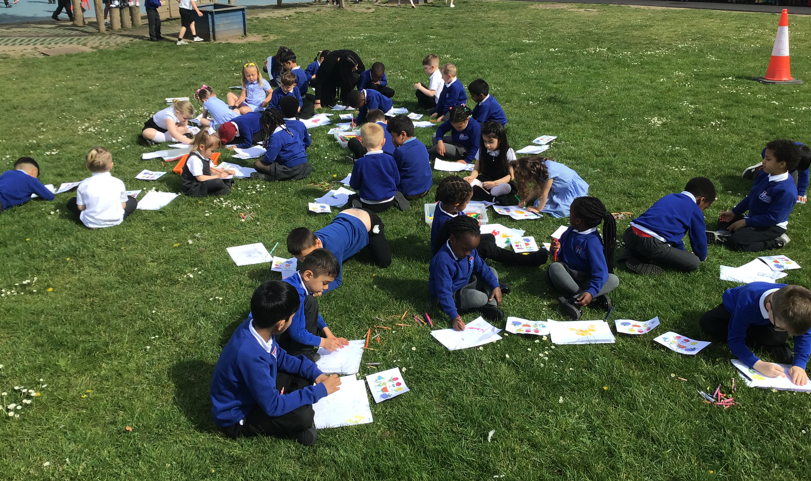
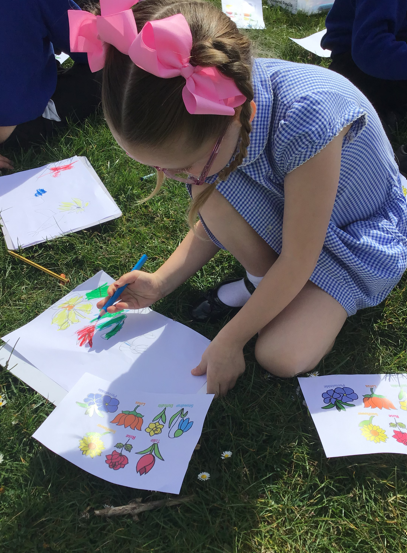
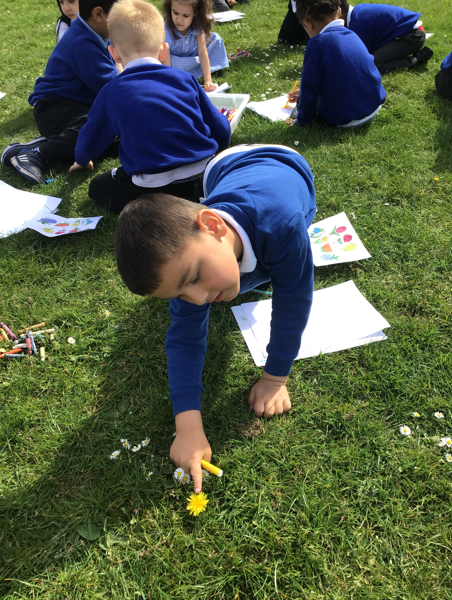
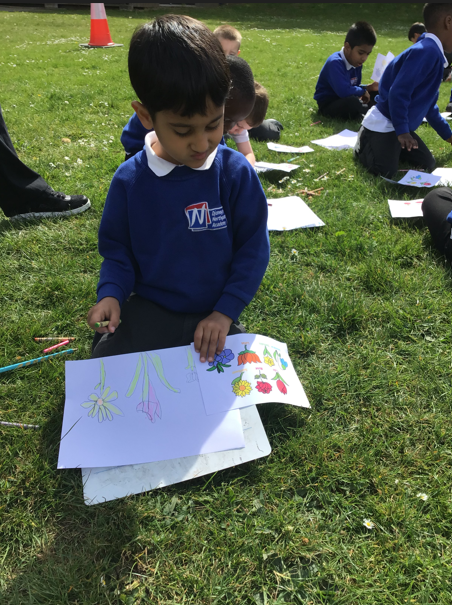

Impressionism - painting
Teaching Art at Northgate
Art is an activity that needs the teacher to be directly involved with the children in the lesson to set the task, to impart knowledge, to lead activities, to monitor and develop the children's progress, to encourage development and to ensure that each child reaches an appropriate standard. All of our medium-term plans are meticulously planned and resourced by the Art Subject Leader to ensure that our teachers are confident in delivering and teaching each pathway. All of our classrooms are resourced with visualisers to enable our teaching staff to explicitly model the high expectations of sketchbook use and new technical skills.
A good art lesson will:
- Use a variety of approaches that are matched to the activity and the ability of the children.
- Give the children time to examine art: work, exhibits, artefacts, historical buildings of interest.
- Identify whether the art activities are exclusively art or whether they are applying skills through one or more aspects of the wider curriculum, as in topic work. When children are undertaking activities that are directly related to another element of the curriculum they should be aware that the session is an art investigation and that they are therefore focusing upon art skills.
- Cater for Special Educational Needs and Disabilities (SEND) children.
- Ensure always that issues of Health and Safety are addressed in the planning and delivery of the art curriculum.
- Encourage children's development of personal and social skills, be fully inclusive and give equal access for pupils to access learning.
- Encourage children to work individually, in pairs, small groups and as a whole class when required.
- Provide learning opportunities that enthuse, engage and motivate children to learn and foster a sense of curiosity and wonder.
- Encourage children to recognise their own ideas have a unique value when creating art.
- Support children to understand that within Art and design, there is no right or wrong. Art can be abstract, and our opinions may differ to what our peers may see or feel.
Supporting ALL children
Teaching in art should address the fact that all children will develop their ability to make images and to learn and apply skills at different rates. Individual children will be supported and intervention from the teacher and additional adults will increase pupils' thinking and raise individual standards. Approaches need to be used to ensure that all children including the least and most able, can be working to their full potential in all art lessons. Different forms of scaffolding in art and design can be utilised by our teaching staff to support all children to reach their potential during the unit of work: knowledge organisers for key vocabulary, pencil grips to support pencil control and fine motor skills, teacher modelling and breaking down a drawing/mark-making process into clear steps.
- Teachers assess children’s knowledge, understanding and skills in Art by making observations of the children working during lessons.
- Teachers use an 'Progression of Skills' document to judge whether a child is working towards, age-related or greater depth in a unit of learning. This enables the teacher and subject leader to see an overview of the children's knowledge, understanding and skills within the strand of art being taught.
- Although verbal feedback is the main tool for providing feedback to children in art and design, post-it notes can be used by peers or teachers in sketchbooks. This prevents children's art from being marked in the process of providing feedback. Teachers will also utilise self and peer assessment during the unit of art.
Sequence of Learning - KS1 Example:
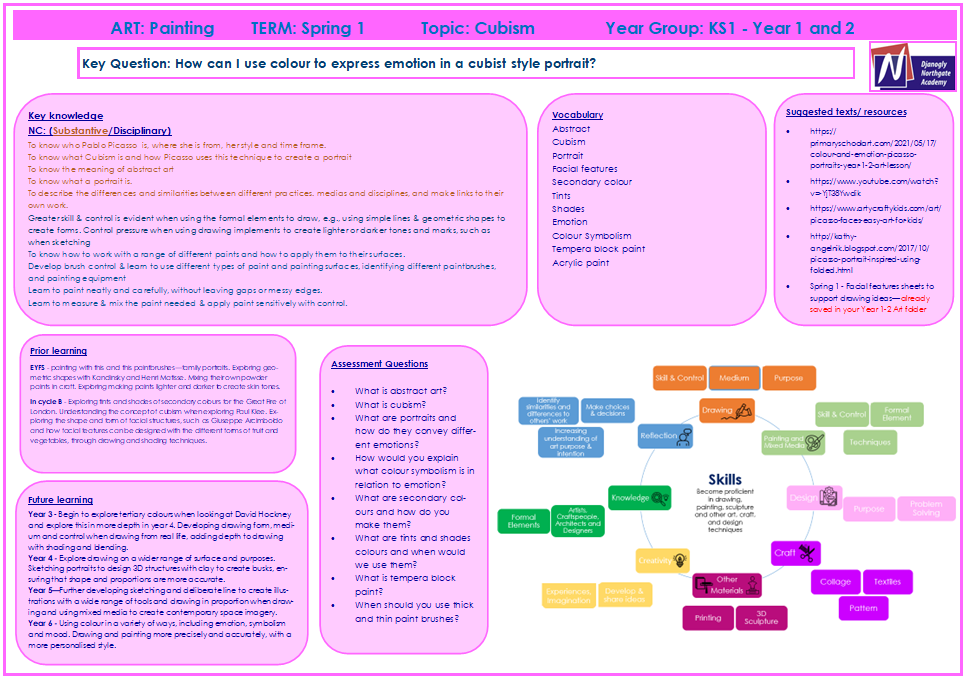
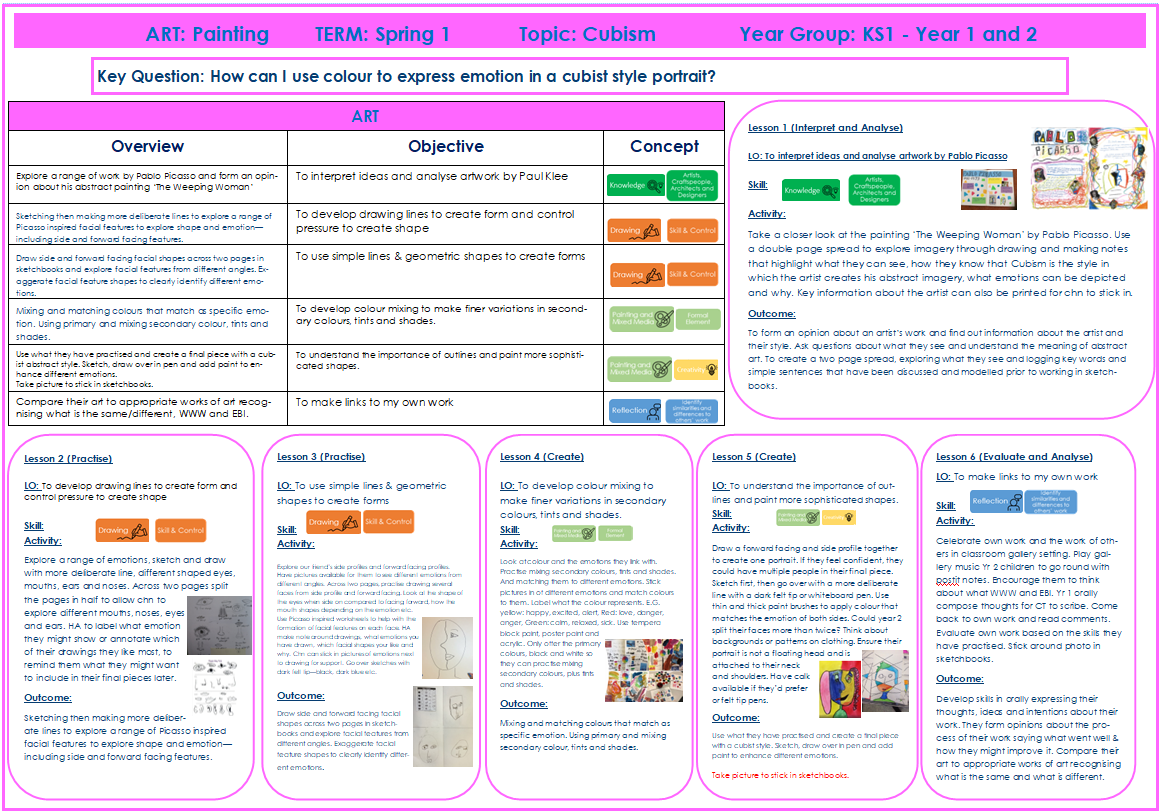
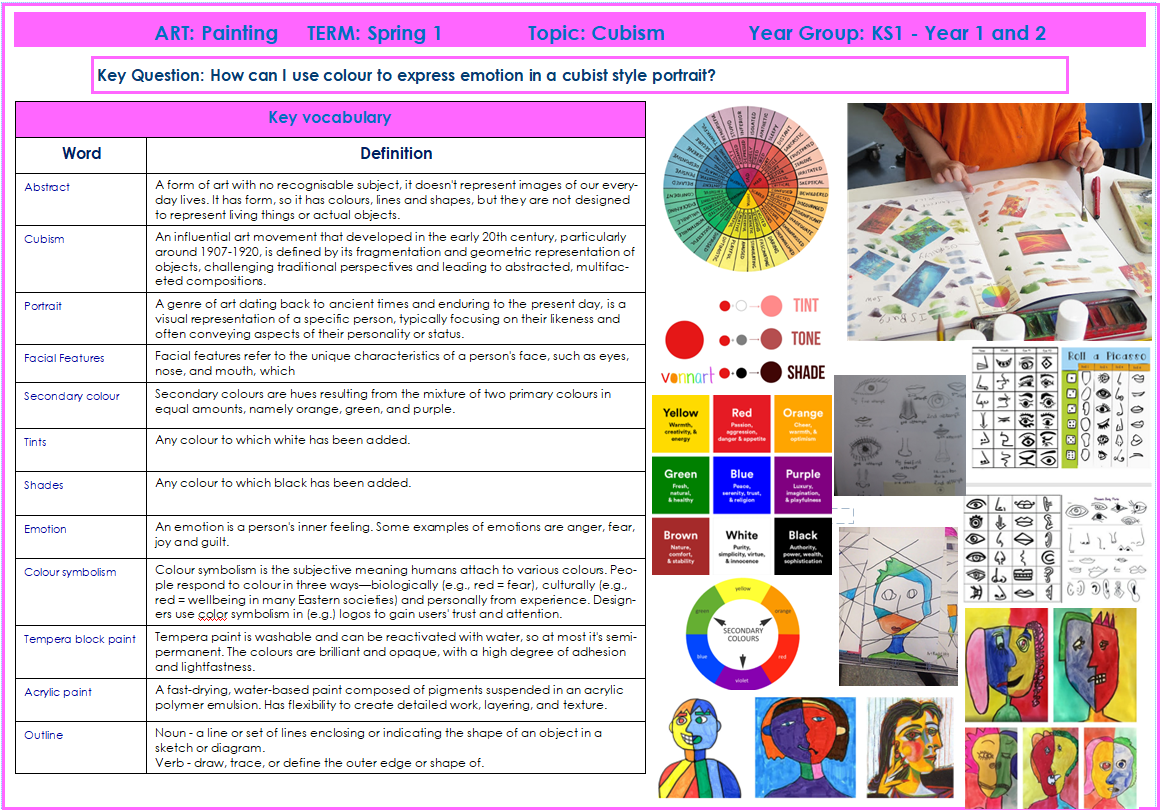
By the end of KS1, children will be able to:
By the end of KS2, children will be able to:
Sketchbooks
Sketchbooks are used from years 1-6 to evidence our art teaching. We believe that sketchbooks provide children with the opportunity to show experimentation and individual creativity. Children will show a sense of pride in their sketchbook, which holds all their ideas and evidence of their learning journey.
Celebrations of Art and Design
At the end of each Art and Design pathway, our children hold private galleries within their classrooms, where they can observe and appraise their own artwork and that of their peers. This allows our children the opportunity to develop the use of evaluation to understand what they need to do to improve and that all artists do this. During this time, they talk about what they feel went well but also what they think could improve their work (thinking about the specific skills they have learnt during this process) and learn that it is normal to feel anxious about the outcomes. They can offer advice, confidence and praise to others, as well as receive this. By Year 6, they will be resilient artists who are ready to understand that the making process of art can be very difficult, and that they should know not to be too self-critical or compare their work to others at their own expense.
Art is celebrated using ‘Wow Walls’ so that children can take pride in their artistic creations. Children’s designs and masterpieces can be seen throughout the environment, encouraging children to comment on their work and previous learning. Towards the end of the year, all children across the school choose the artwork they are most proud of, to display and exhibit at our annual school gallery, NorthTATE. This gives our children the opportunity to express their achievements and articulate their processes and skills to parents and the rest of our school community. NorthTATE caters an enriched environment, where everyone can come together and share artistic experiences, learn from one another and further develop rich conversations about art. We believe it is important for our families to have experiences where they can engage with professional artists who run fun and interactive workshops, and see our children in action, getting excited and enthusiastic about art.
NorthTATE 2024
Impact
The successful teaching of art at Djanogly Northgate Academy will be shown by:
- Children who show clear enjoyment, self-expression and confidence in Art and Design
- The majority of pupils working at or above the age-related expectations
- Children who are creative, curious and critical thinkers both in their art studies and across the curriculum
- A rich vocabulary that enhances both their speech and writing.
Roles and Responsibilities in measuring the impact of art
Subject Leader
Our Art curriculum is high quality, well-thought-out and carefully planned to demonstrate progress. The art subject leader will measure and monitor the way their subject is taught throughout the school by:
- Planning scrutiny
- Work scrutiny
- Learning walks
- Pupil Voice
- Lesson observations
- Teacher interviews
The art subject leader also has the responsibility for monitoring the way in which resources are stored and managed. They provide ongoing CPD to ensure the highest quality of teaching and learning. They will ensure staff have access to current research and knowledge of art, including workshop opportunities with professional artists from nearby galleries.


